
Guided History Of Alaska Airlines
Explore Today's Deals
Alaska Airlines History
Alaska Airlines, with the IATA code AS, has a rich history that dates back to 1932. It is currently the fifth-largest airline in the United States and operates a vast network of domestic and international flights.
The airline was originally founded as McGee Airways in 1932 by Linious "Mac" McGee. It started with a single three-passenger Stinson aircraft and provided flights from Anchorage, Alaska. Over the years, the airline went through several name changes and mergers before becoming Alaska Airlines in 1944.
During the early years, Alaska Airlines primarily served the state of Alaska, connecting remote communities and providing essential transportation services. However, in the 1950s, the airline expanded its operations to the continental United States, offering flights to Seattle, Washington.
More Airline Insights & Tips
Here are a few of helpful resources & tips that can further enhance your knowledge of Alaska airlines and how to best be prepared for your trip:
- Delays are an unfortunate fact of the life of an air traveler. Arm yourself against surprises by knowing the flight status of your AS Alaska flight before heading to the airport, as this could save you a lot of time, or even your trip to the airport if your flight is canceled.
- Info can be found here on Alaska Airlines’s company structure , headquarters, etc.
- See which partnerships and alliances Alaska has here. This is useful if you want to build up your frequent flyer points on partner airlines.
- Want to know which plane types are in service? Check out AS’s fleet list here.
- When considering a flight booking on Alaska Airlines, be aware that third-party travel sites might require you to use their customer service instead of Alaska 's, which may be less than ideal in certain situations.
Beyond the history presented here for Alaska , if you’re wanting more aviation history, read about the history of commercial flight here , or the history of the airline industry here .
Throughout the following decades, Alaska Airlines continued to grow and expand its route network. It acquired several regional airlines, including Horizon Air, which became its regional subsidiary. This expansion allowed the airline to serve a broader range of destinations and cater to a larger customer base.
In the 2000s, Alaska Airlines faced significant challenges due to the economic downturn and increased competition. However, the airline managed to overcome these obstacles through strategic partnerships and a focus on customer service. It forged alliances with major international carriers, such as American Airlines and Delta Air Lines, allowing passengers to access a wider range of destinations worldwide.
Today, Alaska Airlines operates a modern fleet of aircraft, including Boeing 737s and Airbus A320s, and serves over 115 destinations in the United States, Mexico, Canada, and Costa Rica. It is known for its commitment to safety, environmental sustainability, and exceptional customer service.
For more information about this airline, check out our comprehensive Alaska Airlines Guide .
Find more help here for your journey through the airport
A decade of aloha: Alaska celebrates 10 years of flying to Hawaii
- October 12, 2017
- Company News
- Cole Cosgrove
- Click to share on Facebook (Opens in new window)
- Click to share on Twitter (Opens in new window)
- Click to share on LinkedIn (Opens in new window)

Ten years ago today, a Boeing 737 landed in Honolulu and flight attendant Joanie Spring opened the cabin door to a new era for Alaska Airlines.
Alaska’s inaugural hop across the Pacific to the Hawaiian Islands was a dream come true for longtime employees – and for guests who could use their Mileage Plan miles to fly to an exciting new tropical destination.

At the time, it was one of the biggest moments in Alaska’s history.
“That inaugural flight was one of the highlights of my life – the memory still brings tears to my eyes,” Spring said this week, coincidentally, just home from a work trip to Honolulu. “I never thought Alaska would fly to Hawaii, so it was just incredible when we did. I’m still in disbelief 10 years later.”
When Spring started working for Alaska 50 years ago, the airline’s southernmost destination was Seattle. On her first day of training in 1967, then-CEO Charlie Willis told the class that Alaska would start flying to Hawaii “soon.”
“After waiting 40 years, I just had to be on that first flight,” Spring said. Related: 7 tips for people who have never flown to Hawaii
30 daily flights from 10 West Coast cities
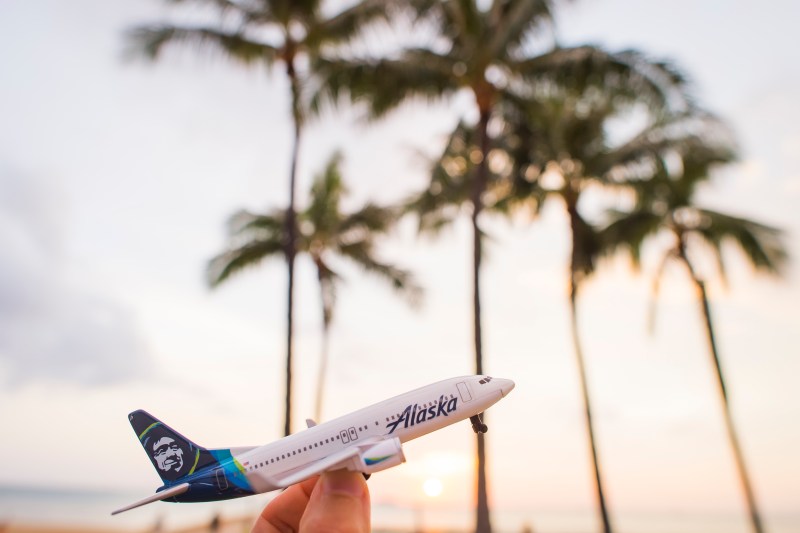
In the past 10 years, Alaska has grown to as many as 26 daily flights to Hawaii – 30 including Virgin America. Hawaii now accounts for about 15 percent of our route network.
“Hawaii flying has meant quite a lot overall to both the company and its passengers,” said Captain Kevin Earp, who flew inaugural flights to Honolulu from both Seattle and Anchorage. “It has opened a world of opportunities for new markets and routes that we were unable to fly previously without ETOPS capabilities. Our experience has also enabled us to fly to Costa Rica.”
Alaska launched our first flight between Seattle and Honolulu on Oct. 12, 2007. Service between Seattle and Lihue, Kauai, started Oct. 28, followed by Anchorage-Honolulu service Dec. 9. In 2008, Alaska began serving Kona on the Island of Hawaii and Kahului on Maui.
Flights to Hawaii: ‘Everyone is happy’

From the West Coast, Hawaii is easy to get to, thanks to Alaska’s nonstop flights from 10 cities to the four largest islands – Kauai, Oahu, Maui and the Island of Hawaii.
“It’s a lot of families, and they’re all kind of excited,” Spring said. “There’s a few business people, and locals who live there. When they come on the flight, everyone is happy to begin with.”

And don’t forget Alaska’s tradition of hospitality – a complimentary Mai Tai or Passion Orange Guava juice along the way.
“It’s one way we show aloha to our guests,” said David Rodriguez, onboard food and beverage product manager.
Last year we served 155,442 liters of Mai Tais. (We also offer Kona Brewing’s Longboard Lager for sale, and many Hawaiian-themed meals over the years.)
When no other airline was catering out of Lihue and Kona, Alaska found small mom & pop caterers for those stations.
“They have been a big success,” Rodriguez said.
Building the foundation for flights

Launching service to Hawaii involved more than just taking off and pointing the nose of the aircraft west. The first step was acquiring 737-800s capable of making the flight to the Islands.
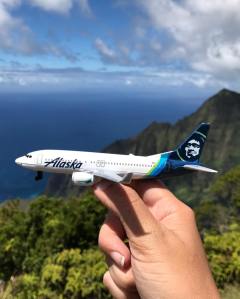
A nearly two-year process to gain approval from the FAA for extended flights over water started in 2005.
Working together, the team developed an ETOPS maintenance manual, trained hundreds of pilots, flight attendants and aircraft technicians, conducted a series of successful simulation flights and more.
Other employees representing virtually every division in the company worked to acquire airport space, set up communications networks, and hire vendors for ground handling, aircraft maintenance, food service and more.
Their efforts opened the door to Hawaii, an exciting new destination and a great growth opportunity for Alaska.
Alaska in the community
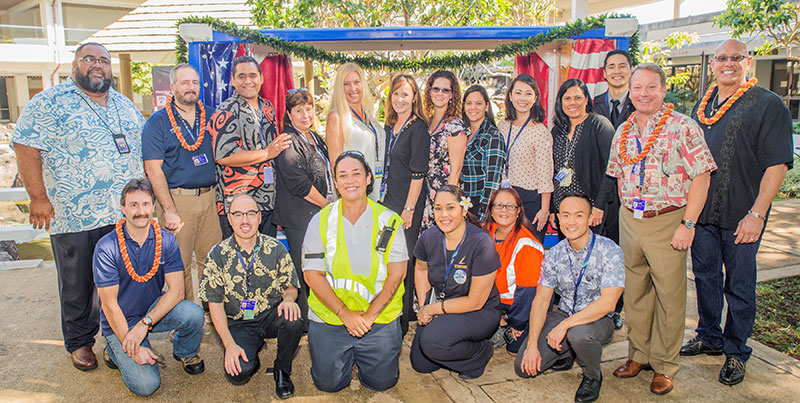
Tropical islands might seem like a curious choice for an airline that grew up in frozen tundra. Although Alaska has been flying to Hawaii for only 10 years of our 85-year history, there seems to be a natural connection between the 49th and 50th states.

“We understand that in Hawaii, as in our namesake state, people have a special reliance on transportation and tourism,” said Daniel Chun, director of sales, community and public relations in Hawaii. “We believe it’s our responsibility to be a good neighbor and support the community. Our commitment to caring for our communities, our guests and each other is a fundamental part of who we are and what we do. In tight-knit places such as Alaska and Hawaii, this is especially important.”
Born and raised in the Islands, Chun leads Alaska’s community involvement and outreach efforts throughout the state of Hawaii.
Over the past decade, Alaska has donated nearly $2.7 million in cash and in-kind services to more than 180 Hawaii organizations.
“Our business isn’t just about flying airplanes. It’s about serving people,” Chun said.
Celebrating the ‘Spirit of the Islands’
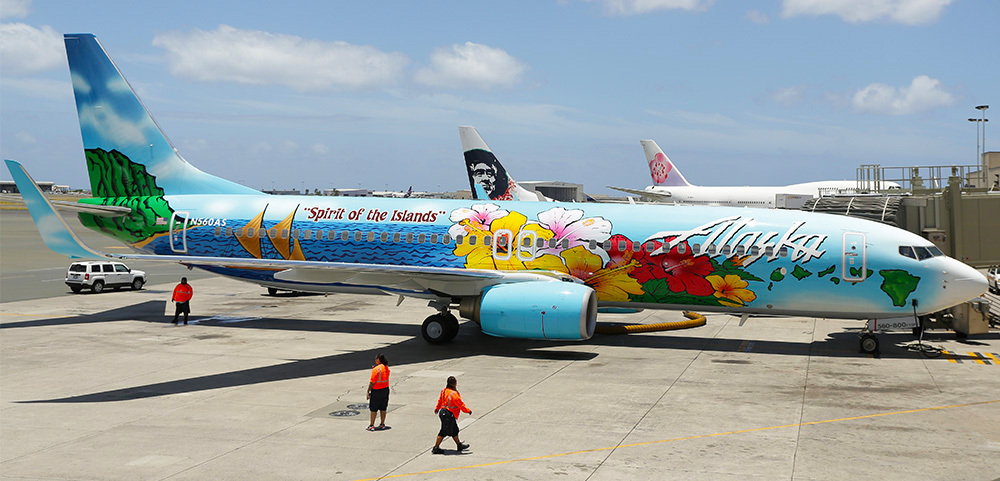
To celebrate our commitment to the people of Hawaii, Alaska proudly flies a specially painted “Spirit of the Islands” 737.

The colorful paint scheme was created by then-17-year-old Aaron Nee as part of a “Paint the Plane” contest in 2013, sponsored by Alaska Airlines in partnership with the Hawaii State Department of Education and Hawaii Association of Independent Schools.
Nee’s winning design displays a voyaging canoe depicting the cultural diversity of the Islands, a bright yellow hibiscus (the state flower), the Hawaiian Island chain and the phrase “Spirit of the Islands.”
A crew of 18 people worked around the clock for 24 days at Aviation Technical Services of Everett, Washington, to paint the plane, which required 26 colors and about 140 gallons of paint, including 20 gallons of primer. In addition, 28,800 yards of masking tape were used.
“The contest helped us to build meaningful and authentic connections with our youth and the result – our ‘Spirit of the Islands’ aircraft – is a source of pride for all of us who call Hawaii home,” Chun said.
Nonstop Aloha: As for the 10th anniversary, Alaska is celebrating with a Nonstop Aloha sweepstakes, where guests from the continental U.S. can enter to win a trip to the Islands. To enter, click here .
Quest for the Golden Pineapple (for Hawaii residents): Learn more.
This story includes information from the Alaska Airlines archives.
Email deals
The latest, lowest fares in your inbox every week.
Sign up now
Alaska listens
Tell us about your recent trip.
Give feedback
For iPhone and Android.
Get the app
Credit card
Alaska Airlines credit cards.
- Even more »
Account Options

- Try the new Google Books
- Advanced Book Search
- Barnes&Noble.com
- Books-A-Million
- Find in a library
- All sellers »

Get Textbooks on Google Play
Rent and save from the world's largest eBookstore. Read, highlight, and take notes, across web, tablet, and phone.
Go to Google Play Now »
Bibliographic information

How Alaska Airlines Became A Major American Airline
Table of contents.
Alaska Airlines is the fifth-largest commercial airline in the United States. Together with its partners, Horizon Air and SkyWest Airlines, Alaska Airlines runs a vast domestic network flying to over 115 destinations in the U.S, Canada, Costa Rica, and Mexico.
Here are a few stats that showcase Alaska Airlines’ growing stature as a major U.S airline:
- Total sales revenue of $3.57 billion in 2020
- Share price of $60.45 as of September 2021
- Market cap of $7.67 billion as of September 2021
- 21,997 employees across all sites in 2020
- Serves 44+ million customers annually
- Flies to 115 destinations with nearly 1200 daily flights
- Total fleet size includes 300+ carriers
Let’s see how the once-obscure small-town airline from the Alaskan wilderness managed to become one of the biggest airlines serving the West Coast of the U.S.A…
{{cta('eed3a6a3-0c12-4c96-9964-ac5329a94a27')}}
The Origins of Alaska Airlines
Alaska Airlines started its journey from the coastal city of Anchorage in the early 1930s. Several airline company mergers occurred throughout this period before the company we know as Alaska Airlines was born.
Throughout its history, the company faced a series of financial constraints right from its inception, which almost resulted in its end. However, it persevered through it all and established itself as the leading charter service in the U.S.
McGhee Meets Star: A Marriage Made in Heaven
It was a fateful day in 1932 when Linious "Mac" McGee decided to use a three-passenger Stinson prop plane and start charter flights from Anchorage.
He worked with a team of pilots to transport goods and passengers across Alaska. These flights were not the scheduled flights of today. Instead, the planes took off once they had managed to fill all available seats with passengers or goods.
At about the same time, in a coincidence that can only be described as serendipitous, two pilots arrived in Anchorage from Seattle and set themselves up as flight instructors of the Star Air Service. They started with a single Deluxe Fleet B-5 two-seater plane but expanded their fleet size to 7.
Two years later, McGhee and Star Air Service decided to join forces, laying the foundation for the largest airline in Alaska with a fleet of 22 aircraft. The following year, McGhee sold his assets in the business to Star but stayed on as manager.
However, the company was off to a bumpy start because of the high repair costs of its planes. Consequently, in 1937, it rebranded itself as Star Air Lines and started focusing on providing regular, scheduled flights instead of its traditional charter flights. The rationale behind this change was to make the company more financially stable, but more trouble was already brewing on the horizon.
The airline business had hitherto been an unregulated sector, but in 1938, the U.S government set up the Civil Aeronautics Authority to regulate the budding airline industry in the region.
In anticipation of these new circumstances, Star Air Lines decided to start paying its pilots regular salaries instead of keeping them on a commission basis. The company also painted its entire fleet with its logo decorated on one side to ensure uniformity.

Alaska Airlines Becomes The Largest Charter Operator In The World
In 1940, the Civil Aeronautics Board started hearings to decide which airlines would receive permission to fly. Two years later, Star successfully obtained temporary licenses to fly on most routes from Anchorage to other destinations. However, the company could not secure the coveted Anchorage to Seattle route, which went to rival company Pan American.
In the same year, company vice-president Homer Robinson decided to expand Star by taking over three smaller airlines - Lavery Air Service, Mirow Air Service, and Pollack Flying Service. Following these acquisitions, the company was named Alaska Airlines - the name it uses today.
By now, the U.S was actively fighting in WWII, and there was an extreme shortage of pilots. The company still managed to power through and purchased its very own multi-engine plane called the Lockheed Lodestar. 1943 was also the year when the company’s stock first opened for investors on the stock exchange.
But the company was still not out of the woods yet. Its ownership had passed into the hands of a New York businessman, and most high-level meetings now took place in New York on the opposite side of the coast. The decision would not prove advantageous.
Following a string of unsuccessful tenures by outsider presidents, the company faced a shortage of funds and equipment throughout the WWII period. Things got so desperate that pilots were forced to buy fuel with their own money.
That would all change with the arrival of president James A. Wooten in 1947. Wooten capitalized on the post-war deregulation of the airline industry. He also took advantage of equipment left over from WWII, which the government was practically giving away. Using this newfound equipment, Wooten was able to expand the fleet size enormously.
Due to relaxed regulations and increased fleet size, Alaska Airlines could return to its original charter flight business. The company could send its planes to virtually any corner of the globe to transport goods and passengers. By 1948, Alaska Airlines had become one of the largest charter operators in the whole world.
Key Takeaway 1: Perseverance Is Key To Survival
In those initial days, getting an airline business off the ground was extremely difficult. From passengers and pilots to high plane repair costs, obstacles were aplenty.
Yet, the company managed to stay afloat by making strategic mergers and acquisitions with other airline companies. Had the company given in and not made any attempts to spread its wings in the industry, it would not have become the largest charter operator in the world.
This is also signaled to the rest of the airline industry what sort of company was entering the arena: a resilient one, indeed.
Alaska Enters The Age Of Marketing
%20(1).jpg)
In 1949, CAB mandated regulation was back in full force. It prematurely halted the boom in international business that the company had enjoyed under Wooten.
The airline could no longer continue its lucrative charter business, which led Wooten to resign as president. Consequently, Alaska Airlines began to firmly establish itself within Alaska by acquiring two smaller airlines to expand its fleet locally.
The CAB Steps In
The company’s troubles were far from over. In 1951, CAB removed the President of Alaska Airlines over allegations of financial impropriety and brought in their own candidate: Nelson David.
Surprisingly, CAB’s heavy-handed move worked in the long run. The new president Nelson David was able to revive the company’s financial situation and strengthen operational stability. The following year, Alaska Airlines also finally obtained a temporary license for the long-awaited Anchorage-Seattle route.
Another significant breakthrough came when the company finally acquired a DC-6 which was the first pressurized plane. It allowed pilots to fly above bad weather and avoid turbulence altogether rather than fly through it.
By 1957, the airline's operations were finally running smoothly again, and David decided to step down and make way for the new owner Charles F. Willis.
Before taking over the reins as chairman and CEO, Willis had bought up a significant chunk of the company's shares.
Willis was no stranger to flying, having served as a commendable pilot in WWII. But besides his knowledge of aviation, he also had another talent: marketing.
Some even described him as a born marketer, and Willis certainly had several strategies in mind to get passengers to sit up and take notice of the airline.
Charles Willis - The Marketing Mastermind Behind Alaska Airlines
The first thing Willis did was introduce in-flight movies for passengers. At that time in the late 50s, the concept of in-flight entertainment was virtually unheard of, so Willis’ novel move ensured that Alaska Airlines grabbed the attention of travelers.
He also kickstarted a Golden Nugget service, which allowed passengers to enjoy musical performances onboard Alaska Airlines. Not to mention the numerous fashion shows and bingo games that Willis introduced to reel in more customers.
At this point, the company was facing stiff competition from major rivals like Pan American and Northwest. Willis came up with even more aggressive marketing strategies that almost bordered on cheap publicity stunts to offset his rivals. For instance, the new promotional plan was to convert safety instructions into fun rhymes.
However, the early 60s were not just about marketing ploys to get more customers. 1964 was an important year for Alaska Airlines for an entirely different reason. It was the year the company finally managed to win a permanent license for the lucrative Seattle-Anchorage route.
It was also when the company bought a massive cargo plane called the Lockheed Hercules to transport oil-drilling equipment to Alaska’s North Slope.
Marketing still remained the focal point of the airline’s strategy throughout this period. On the eve of 1967, the airline began a Gay 90s promotional scheme to mark Alaska's 100th-anniversary celebrations. Flight attendants would serve passengers dressed in vintage Edwardian-era clothing.
It was also when a new airport opened in Sitka in the southeast part of Alaska. The airline capitalized on this opportunity to extend its service to this part of Alaska by offering direct flights to Sitka airport. To do this, it successfully pitched itself to CAB and won exclusive rights to provide flights to southeast Alaska.
The following year, Alaska Airlines acquired two established Southeast airlines, Alaska Coastal-Ellis and Cordova. The merger was finalized because Alaska Airlines needed to increase its fleet size to better service Sitka airport.
By 1970, the Golden Samovar theme replaced the Gay 90s theme, replete with flight attendants dressed in Cossack costumes and serving drinks from a traditional Russian samovar. It was done to celebrate the start of the charter service to Siberia. It was a massive victory on the part of Alaska Airlines that it could get permission to provide flights to Russia even during the height of the Cold War.
Key Takeaway 2: Market Your Way Ahead Of The Competition
The airline industry was getting hotter with multiple competitors in the market while Alaska Airlines was struggling with its own internal share of problems. The way out came in the form of unique and aggressive marketing.
From leveraging flight attendant uniforms to introducing in-flight entertainment, the company undertook several measures which made it stand out from the rest of the airlines. Thus, even though customers had other options to travel on the same route, they opted for Alaska due to its captivating marketing effort.
Hence, the company fended off the competition and resumed its path of growth.
Deregulation and An Era Of Unprecedented Expansion
By 1972, the company owed almost $22 million in debt. To make matters worse, the company's cargo planes had been sitting idle because the oil drilling work in Alaska had come to a stand-still. This meant a plunge in profits.
If that wasn’t bad enough, the company had also acquired a reputation for poor customer service because flights would not run on time. To deal with this crisis, the board of directors replaced Willis with Ronald F. Cosgrave.
Coming Back On Track
Immediately after taking over, Cosgrave made some tough decisions to keep the company going. He cut down on staff and stopped flights for the less profitable routes. He also dropped the cargo transportation business altogether.
By 1973, the company was back on track and moving towards financial stability again. Under Cosgrave's lead, the airline also improved customer service by ensuring that flights ran on time. As a result, the airline was able to start making a decent profit again.
But Alaska Airlines was aiming at more than just financial stability. The company wanted to grow and provide service not just in Alaska but in other U.S cities. It also knew that none of this would be possible under strict CAB regulations.
So, the airline set out on an ambitious lobbying campaign and successfully convinced Congress to pass the Airline Deregulation Act of 1978, which radically transformed the airline industry.
Tripling The Fleet Size And Expanding Service

The same year deregulation took effect; Bruce R. Kennedy became the new CEO of Alaska Airlines. His goal was to make the most of the newly deregulated market of the 1980s to expand the airline’s service to other U.S cities.
The company was already catering to 10 cities in Alaska and Seattle, but following deregulation, it started providing flights to three major U.S cities: Portland, Oregon, and San Francisco.
Next came Palm Springs in California, and the company also added the cities of Nome and Kotzebue to the airline's route. By 1981, the airline also started flights to the cities of Burbank and Ontario in California.
This expansion of service continued steadily until 1985. The company had successfully increased its customer base from Alaska to other parts of the U.S, such as Southern California, Oakland, San Jose, Spokane, Boise, Phoenix, and Tucson.
It was a period of unprecedented growth for Alaska Airlines, and profits were at an all-time high. That same year, the Alaska Air Group was set up in anticipation of further expansion. It was essentially a holding company for Alaska Airlines.
In 1986, the Alaska Air Group also brought Horizon Air and Jet America Airlines under its management. It allowed Alaska Airlines to triple in size, seeing a five-fold increase in its fleet size.
But the Jet America Airlines merger was by no means an easy one. The Californian market was highly competitive, and Alaska had to compete against significantly more prominent and well-established local rivals. But the airline persevered and, in the end, managed to successfully acquire Jet America Airlines to expand service in Californian cities.
Another major problem for the airline at the time was the seasonal nature of travel in Alaska. Due to the harsh winters, most people preferred to fly during summer, and business would lag in the winter months.
To make up for this lack of business, the company needed to increase travel in the winter months. So, Alaska Airlines came up with a clever strategy to offset its losses in winter by expanding its service to Mexico.
Hence, 1988 saw the airline expanding its service to the Mexican cities of Mazatlan and Puerto Vallarta. These cities experienced milder winters than Alaska and were a popular destination for tourists in the winter.
Moreover, Alaska focused squarely on improved customer service to entrench itself in these new cities and outpace its rivals. It ensured that its passengers had a comfortable flight by providing more legroom than other airlines and better quality food.
By 1989, the airline had gone from catering 10 cities in Alaska to serving 30+ U.S cities and Mexico and Russia.
Key Takeaway 3: Taking The Tough Decisions When It Matters The Most
Piling debts and plunging profits meant Alaska Airlines was in a shaky situation. This was when Cosgrave took over and immediately made some tough decisions, such as cutting down staff and shutting down loss-making routes.
These measures allowed the company to regain financial stability and sustain itself for the time being. Eventually, a few years later, the airline was able to expand its fleet size and enter new markets.
Thus, making the right calls and at the right time can prove to be monumental for a company in the long run.
Becoming A Low-Cost Carrier To Get More Customers
As the 1990s arrived, the airline industry was undergoing some significant changes. In the face of increasing competition, it became essential for Alaska Airlines to streamline its cost structure to provide more affordable flights to customers.
Plus, it was necessary to keep customers loyal to Alaska Airlines as cheaper commercial carriers like MarkAir Inc appeared on the scene.
Giving Customers Better Service At The Same Price
In 1990, the board of directors decided to sell $60 million worth of stock to International Lease Finance Corporation (ILFC), responsible for leasing airplanes. The rationale behind this move was quite creative, and in the long run, it benefitted Alaska Airlines enormously.
One of the conditions that Alaska put down when transferring the stock was that Alaska Airlines’ managerial staff would hold all conversion rights. The team was responsible for redeeming the stock back from the ILFC by 1997.
They solely put in this condition to motivate employees to ensure strong stock performance by boosting operations. It worked splendidly because the staff now had a personal stake in the performance of the stock. To achieve this end, the airline had started a large-scale employee stock purchase scheme.
The strategy worked so well; the airline reported profits at an all-time high, and it was praised for its excellent customer service.
At this point, CEO Kennedy stepped down, and Raymond J. Vecci took over. However, Vecci faced some significant problems right from the onset of his tenure.
In 1991, a deal to purchase local Alaskan carrier MarkAir Inc fell through. Consequently, MarkAir Inc began competing with Alaska Airlines by providing cheaper flights to customers in the company’s home base Alaska. It began to cut into Alaska Airlines profits, and for the first time in 20 years, the company reported a loss of $121 million.
To combat this issue, the airline decided to adopt the low-cost/low-fare model. Instead of purchasing new aircraft, the company improved the utility of its existing planes. The company also stopped flights along less profitable routes and started economizing on in-flight services. In the short term, this helped the airline to decrease its losses to just under $45 million in 1993. By 1994, the company had even started to generate a decent profit once more.
However, Alaska Airlines was aware that solid customer service alone would allow it to stay ahead of the competition in the long run.
So, even as more rivals like low-cost Southwest Airlines appeared on the market, the airline was determined to provide low-cost flights without compromising on customer care.
Transitioning To An All-Boeing Fleet
To maintain its service provision standard, Alaska Airlines decided to explore more innovative solutions.
In 1996, the airline became the first commercial carrier to incorporate GPS navigation technology with Enhanced Ground Proximity Warning System. It also added a real-time display of the terrain to guide its pilots. It showcased the airline's commitment to passenger safety and security.
To further facilitate its customers, the company also decided to start selling tickets online. It installed Instant Travel Machines that helped customers print their own boarding passes so that they would not have to stand in line and wait at the ticket counter at the airport.
By the year 2000, the airline had also added automatic external defibrillators on all its plane to prevent in-flight emergencies escalating. It was a life-saving measure taken by the company.
As the 21st century rolled in, Alaska Airlines again entered a period of expansion extending service to Boston, Chicago, Dallas, Denver, Miami, Newark, Orlando, and Washington D.C. The company also started flights to Hawaii and began servicing more destinations in Mexico.
To adequately provide service to all these new destinations, the company expanded its fleet to an all-Boeing 737. These planes were more efficient and reduced fuel costs.
Key Takeaway 4: Restructuring To Suit Demand Of Customers
With MarkAir’s arrival, Alaska experienced its first loss-incurring years in over 2 decades. Realizing the low-cost model was attracting customers, Alaska Airlines decided to change its ways too.
Instead of following expansion policies to grow as it had in the past, the company opted to adapt to the new low-cost structure by improving the efficiency of its existing fleet and economizing its costs. Simultaneously, it did not compromise on customer service and added features such as online tickets.
Hence, the company entered a new phase of growth and efficiency.
Transformation Plan - Alaska 2010
This decade was marked by a focus on pioneering new technology and providing better service to customers. The company also launched an ambitious Alaska 2010 plan to safeguard the company from the boom and bust cycles of the airline industry.
Introducing Flights on the East Coast
During the early 2000s, the company focused on expanding service to cities located on the East Coast of the United States. In 2002, Alaska started direct flights to Newark in New Jersey. The following year, it extended service to Orlando and Boston.
In June 2006, the company purchased new aircraft to fulfill the needs of remote Alaskan towns better. The new 737-400C "combi" aircraft had 20% more capacity and easily transported goods and passengers to small Alaskan towns.
In the years that followed, Alaska Airlines remained committed to providing service to more U.S cities. In 2007, the airline launched non-stop service to Portland, Oregon, and Boston. The following year, direct flights were started from Seattle to Minneapolis.
In 2009, the company started direct flights from Seattle to Houston, Austin, and Atlanta. By 2010, Alaska Airlines had successfully achieved its goals as per the Alaska 2010 plan. This plan was developed after the economic fallout from 9/11. Rather than looking to the government to bail them out, the airline doubled down and worked out a plan to get back on its feet.
In the years leading up to 2010, the company focused on growing market share and improving productivity by cutting costs. They also focused on modifying their routes to make them more profitable by better utilizing capacity.
Compared to other commercial carriers, Alaska was ranked number 1 in productivity and price recovery during this period.
Pioneering New Technology
2010 onwards, the company also created multiple mobile applications to take advantage of social media to communicate with customers. This initiative is part of the customer-first policy of Alaska Airlines.
In 2011, Alaska Airlines was the first to partner with Boeing and Fujitsu to use a new technology called Component Management Optimization. This technology allowed ground staff to quickly scan different aircraft parts with a handheld device to determine whether they needed to be replaced. The new initiative considerably sped up routine aircraft inspections.
The same year, the airline provided all its pilots with iPads in an attempt to replace extensive paper manuals. The company also experimented with replacing jet fuel with bio-fuel to project itself as an environmentally-friendly airline.
Key Takeaway 5: Rely On Innovation & Technology To Move Forward
For both ground and flight operations, the future relies on technology. Alaska Airlines quickly realized this and introduced a series of innovative technologies such as the CMO for ground staff and iPad manuals for aircrew.
These steps improved the efficiency of staff and reduced costs for the company. At the same time, Alaska leveraged innovation to opt for bio-fuel for its planes, further showing the company’s commitment to futuristic growth.
The Pandemic Comes In The Way Of Alaska’s Flight
By launching mobile applications, the Component Management Optimization, and iPad manuals, along with the biofuel jet project, Alaska Airlines had set the tone for the years to come: innovation and sustainability.
Simultaneously, it did not let go of its ambitious plans to grow its operations and expand its fleet to become the region's largest airline.
Dominating The Skies & The Ground Services
Alaska Airlines made it clear that they were going to pursue a rigorous expansion and leave no stone unturned in order to achieve. The most notable move came in 2012 when the company announced its largest order of new aircraft consisting of:
- Twenty 737 MAX 8s,
- Seventeen 737 MAX 9s
- Thirteen 737-900ERs
This addition to the fleet was estimated to value around $5 billion, putting the company in competition with some of the biggest carriers in the country.
A few years later, in 2016, Alaska also launched its own airline services company, McGee Air Services. This subsidiary enabled the airline to take charge of its own ground handling, aircraft cleaning, etc.
However, this was in no way the biggest news of the year. Alaska announced one of its most strategic and monumental mergers ever. It took over Virgin America for a whopping $2.6 billion, and although they continued to operate as separate airlines, the combined operation consisted of over 275 airplanes and 1200+ flights to around 800 destinations.
The following year, the company announced the two airlines would now fly under one banner, with the Virgin America brand officially retiring in 2018. Now, Alaska Airlines is the premier airline of the West Coast!

Responding To The Pandemic
Soaring high above the sky, Alaska was on an unprecedented trajectory upwards. But everything changed when the first cases of the COVID-19 virus were detected. Not only was Alaska Airlines severely affected throughout the course of the pandemic, but the whole airline industry went through probably its most testing time ever.
This was when Alaska Airlines took up the challenge to ensure the safety and health of its passengers and, for the time being, take a hit in its profits.
From banning over 700 passengers that violated safety protocols to coming with unique marketing techniques and frequent flyer incentives, the airline covered all its bases during the pandemic.
The airline also introduced contactless procedures for check-ins and food orders, which not only boosted the customer experience for the short term but also laid the platform for the future.
Thus, despite suffering billions in losses, the airline is all set to fly high again as air travel slowly resumes to normal.
Key Takeaway 6: Always Seek New Opportunities For Growth
At the start of the decade, Alaska Airlines was already a giant in the industry, but as a futuristic company, it planned ahead and still found new opportunities to grow.
In fact, the takeover of Virgin America established it as the airline of the West Coast and ensured its place ahead of any competition in the region.
This move, along with a proactive approach, also allowed the company to navigate the turbulence of a global pandemic and get ready to make a comeback.
Summary & Key Strategic Takeaways

The rise of Alaska Airlines to become one of the USA’s top airlines is quite impressive. It faced numerous challenges along the way but its pro-active response and tailored strategies meant that it is still flying high.
Growth By Numbers
Key strategic takeaways.
Here are some of the most vital strategies we learn from Alaska’s journey.
Never Give In
From facing regulations of the airline industry to shortage of pilots and ever-increasing costs during WWII, the newly found charter airline was surrounded by challenges.
Yet, every time the company faced a problem, it found a way around it; sometimes, in the form of mergers and acquisitions, and other times in the form of structural tweaks, such as offering salaries to pilots instead of commissions.
This helped the company survive its initial phase and enabled it to exponentially scale its operations and become of the largest charter airlines in the world only a few years after WWII.
Establish A Unique Brand Identity
Alaska Airlines’ competitors, such as Pan American, meant that customers had a variety of options to fly on the same routes as Alaska. Thus, the airline needed a way to stand out and entice customers to travel with them.
Here is where the company invested in marketing strategies, such as Golden Nugget in-flight entertainment and special event uniforms for flight attendants.
Hence, passengers had something to look forward to Alaska Airlines’ flights which they couldn’t find elsewhere.
This unique brand contributed greatly to the brand’s progress and competitiveness.
Make Timely & Effective Changes
Every company faces challenges that threaten its survival. When Alaska Airlines was in such a phase, it responded actively and made key decisions of reducing the workforce and reorganizing its routes.
Had the company not taken these steps timely, it would have been a steep journey downhill.
Instead, very soon, not only was the airline back to normal, but it was also looking to boost its operations and add to its existing fleet.
Adapt To Situation When Needed
Mostly, in Alaska Airlines’ history, growth had been directed through adding routes and planes to the company’s portfolio. But when MarkAir’s entry into the market caused the company significant losses, it took a new approach.
Adopting the low-cost model, reducing operational costs, and boosting customer service, Alaska Airlines regained its share in the market without expensive expansions. Rather, it improved efficiency, allowing it to grow internally.
Stay On Top With Technology
To become and continue to be a premier airline in the future, Alaska Airlines knew the importance of technology and innovative solutions. Therefore, it enhanced its operations through tech upgrades that allowed better handling of its aircraft and facilitated its employees in complex tasks.
The airline also moved towards eco-friendly fuels to reduce its costs and show its stance as a responsible company, positioning the company for growth in the future.
Always Look Ahead
Despite achieving considerable success and already becoming a top airline, Alaska Airlines did not stop. It went ahead with even more ambitious plans, such as a huge fleet order and merger with Virgin America.
Hence, its big operations became bigger - biggest, in fact, on the West Coast, and resultantly, the airline was far ahead of any of its competitors in the region.
Alaska Airlines Mileage Plan award chart changes are now live

If you're a loyal Alaska Airlines Mileage Plan member, buckle up. In November 2023, the carrier announced a new award chart set to take effect in March 2024. Now, the major award chart update has begun, and the new pricing will start rolling out Monday, March 11, through March 31.
While Alaska leaders touted this as a major enhancement, our preliminary research showed that it's a mixed bag compared to previous award rates — especially if you're looking to book Alaska partners in 2024. However, the changes do offer some notable simplicity that was previously missing, with different partners having wildly different award rates when traveling between the same regions.
"As a Mileage Plan member, our guests deserve to travel the world with ease and convenience," Brett Catlin, vice president of loyalty, alliances and sales at Alaska Airlines, said in a press release. "That's why we have made some changes to our award pricing and inventory, to give them more options, simplicity, and great value for their miles. Whether they want to explore a new destination, visit a loved one, or take a relaxing vacation, they can now find more award availability and flexibility for their travel plans."
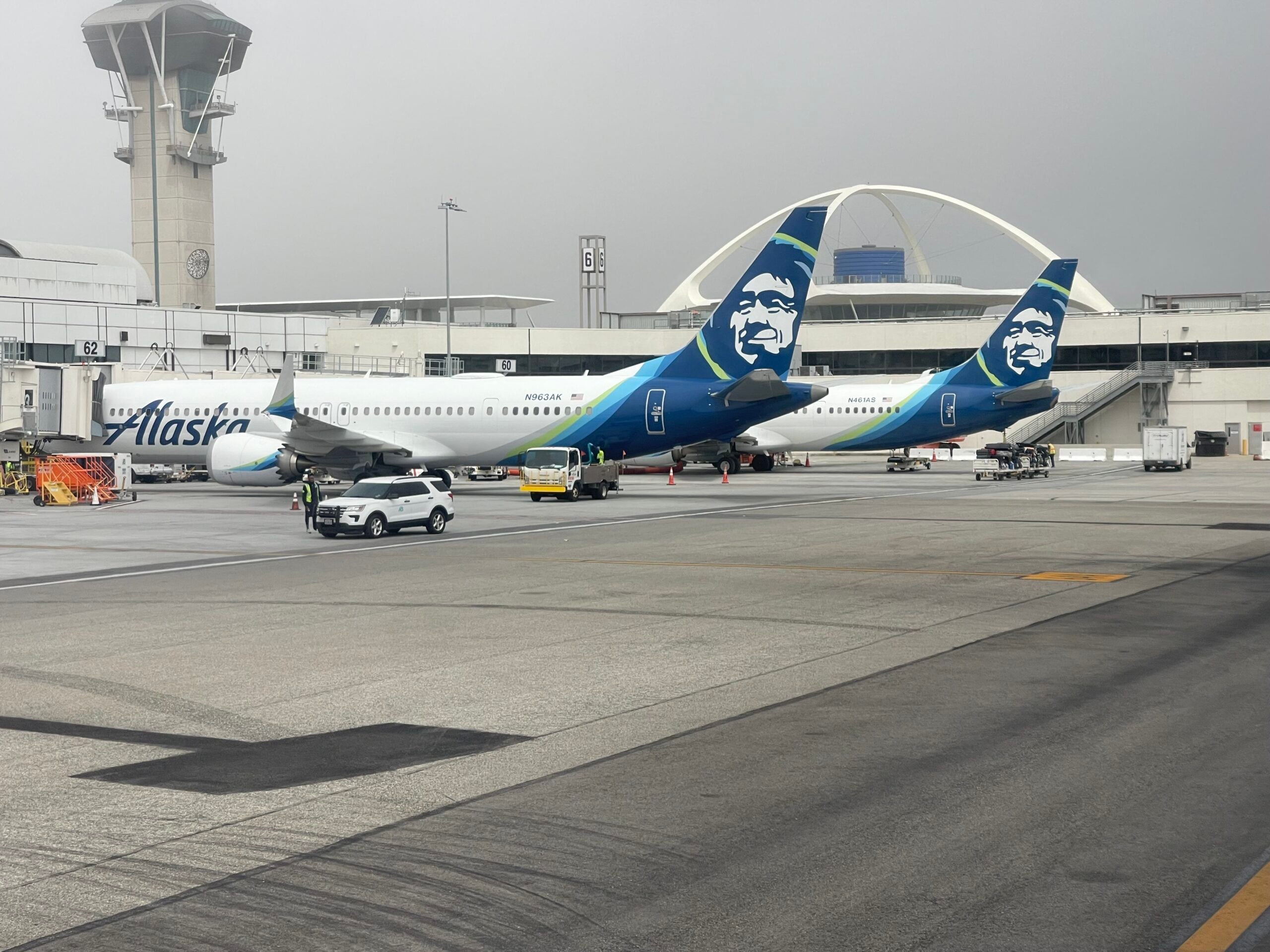
So, what changes did Alaska Airlines make to its Mileage Plan award chart ?
Related: The best websites for searching Oneworld award availability
Alaska Airlines Mileage Plan 2024 award chart redemption changes
Beginning on March 11, Alaska Airlines started rolling out its new award chart pricing changes. The Mileage Plan award chart now has a new distance-based structure and is divided into three region-based charts: the Americas; Europe, Middle East and Africa; and Asia-Pacific. The chart shows redemption rates will vary based on the distance being flown.
The Americas
The first region is the Americas — which includes North America, the Caribbean, Central America and South America. These prices apply to flights flown between (or within) these areas.
Note that Hawaii, the Caribbean and Central America are no longer included as separate regions (as they are on the current award chart). Instead, flights to or from these areas will follow the above pricing.
Europe, Middle East and Africa
The next region is Europe, the Middle East and Africa (EMEA). The prices below apply to flights within these three areas and to flights from the U.S. to any of these areas.
The final region is Asia — which includes Southeast Asia, the Indian subcontinent, Japan, Korea and the South Pacific. These prices apply to flights within these areas, between these areas and EMEA, and between the U.S. and these areas.
There's a lot to unpack here, so let's look closer at some of the regions.
Flights within the Americas
Under the previous award chart, most award flights within the Americas were already distance-based (excluding those to South America). For example, an economy award flight within (or between) the contiguous U.S. and Alaska or Canada that is less than 700 miles started at 5,000 Mileage Plan miles. In the new award chart (effective March 2024), flights less than 700 miles in economy will start at 4,500 miles. Meanwhile, flights that cover between 701 and 1,400 miles will retain a starting price of 7,500 miles.
However, many longer flights will see an increase:
- Economy flights within (or between) the contiguous U.S., Alaska and Canada covering 1,401 to 2,100 miles: Going from 10,000 miles to 12,500 miles (a 25% increase)
- Economy flights within (or between) the contiguous U.S., Alaska and Canada covering 2,101 to 4,000 miles: Going from 12,500 miles to 17,500 miles (a 40% increase)
- Economy flights from the U.S. to Hawaii covering 2,101 to 4,000 miles: Going from 15,000 miles to 17,500 miles (a 16.67% increase)
At the time of writing, there are still several months that feature both the previous award pricing as well as the increase. For example, in September 2024, you can book a one-way award flight in economy from Seattle to Anchorage for 10,000 miles. If you book a later flight, it will cost 12,500 miles.
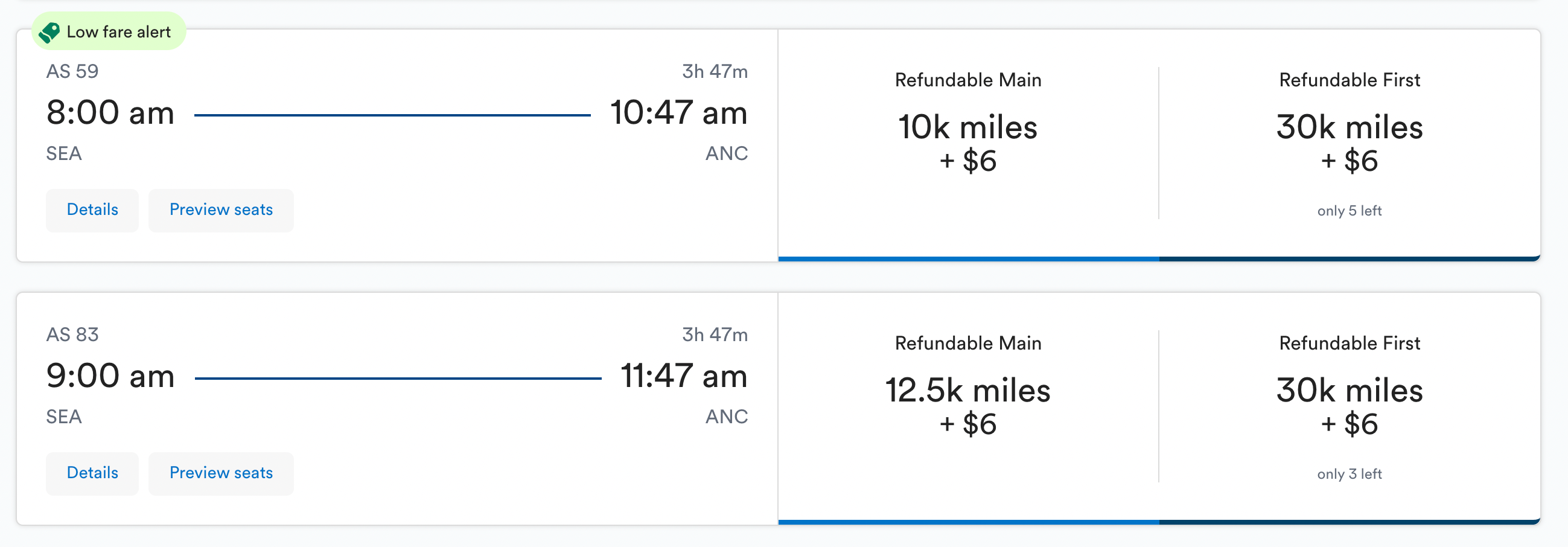
It's a similar story for flights from the U.S. to South America (which are operated by partners LATAM and American Airlines). Previously, economy awards from the U.S. to any South American destination started at 20,000 miles, but as of March 11, these will be even lower:
- Less than 1,401 miles: Starting at 7,500 Alaska miles
- 1,401 to 2,100 miles: Starting at 12,500 Alaska miles
- 2,101 to 4,000 miles: Starting at 17,500 Alaska miles
Unfortunately, the award rates for one of Alaska's top sweet spots are increasing. Starting in March, long-haul flights on LATAM covering between 4,001 and 6,000 miles, which currently start at just 45,000 miles each way, will climb to 50,000 miles — an increase of 11.1%.
International flights
It's a similar story on the EMEA and Asia award charts, as some prices are dropping while others will see some notable increases — especially for premium-cabin redemptions.
Here's a snapshot of some popular routes that are changing.
Fiji Airways
Under the current award chart, you can fly from the U.S. to Fiji's Nadi International Airport (NAN) for just 55,000 miles in business class. Amazingly enough, that price also applies if you connect through Fiji to Australia or New Zealand.
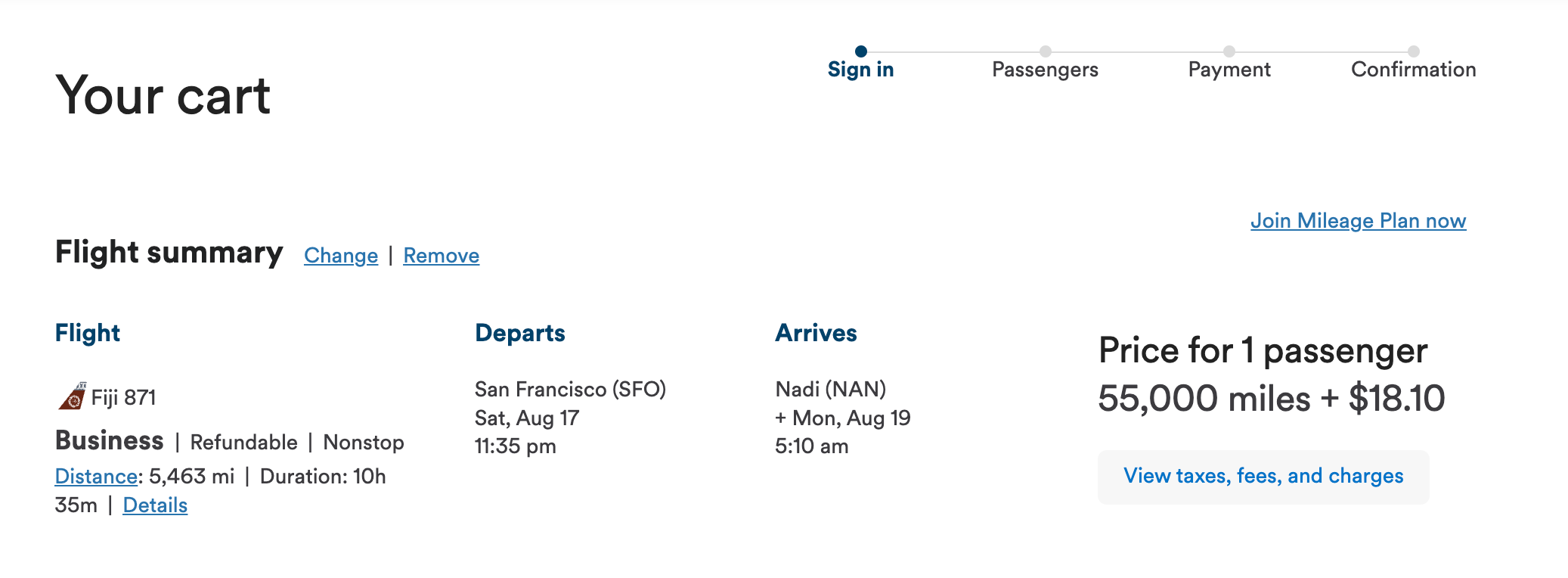
The new award chart will price these business-class awards as follows:
- U.S. to Fiji: 75,000 miles
- U.S. to Australia via Fiji: 85,000 miles
However, the starting price of nonstop economy tickets from the U.S. to Fiji will drop slightly — to 37,500 miles.
Japan Airlines
The award rates for nonstop flights from the U.S. to Asia on Japan Airlines fall at 35,000 miles for economy, 50,000 miles for premium economy and 60,000 miles for business-class award tickets.
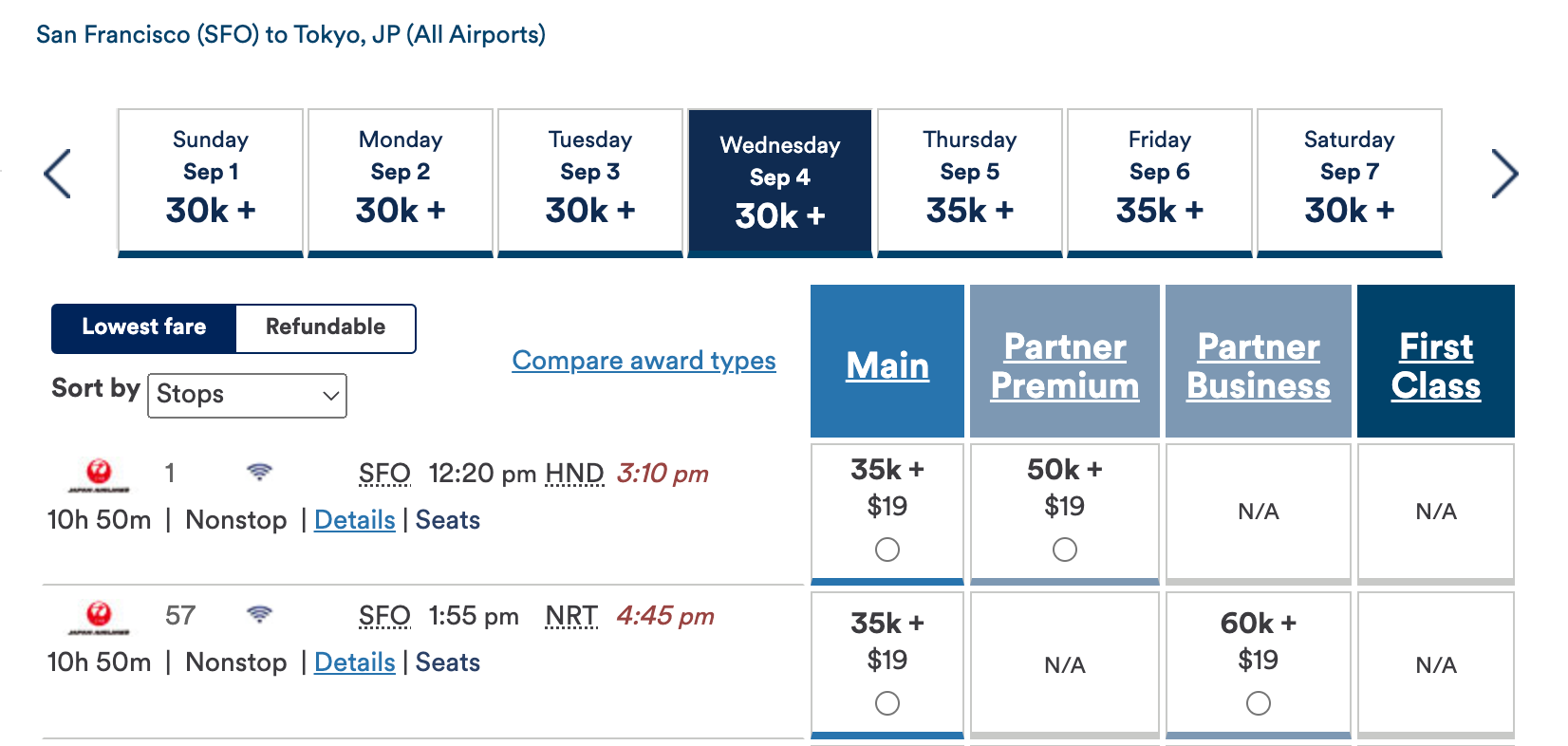
For the new chart, only certain flights to Tokyo — from either Seattle-Tacoma International Aiport (SEA) or Vancouver International Airport (YVR) will be priced the same or lower (30,000/40,000/60,000). However, flights from other U.S. gateways to Tokyo will start at the following rates:
- Economy: 37,500 miles (up 7.14%)
- Premium economy: 50,000 miles (no change)
- Business: 75,000 miles (up 25%)
Note that if you add a connecting flight and your total distance exceeds 7,000 miles, you'll get bumped into the next pricing band.
Starlux Airlines
In 2023, Alaska added Starlux Airlines as a redemption partner, with some amazing redemption rates (that only lasted about 24 hours). However, you can still find some Starlux awards at 85,000 miles in business class, like this routing from San Francisco International Airport (SFO) to Singapore Changi International Airport (SIN).
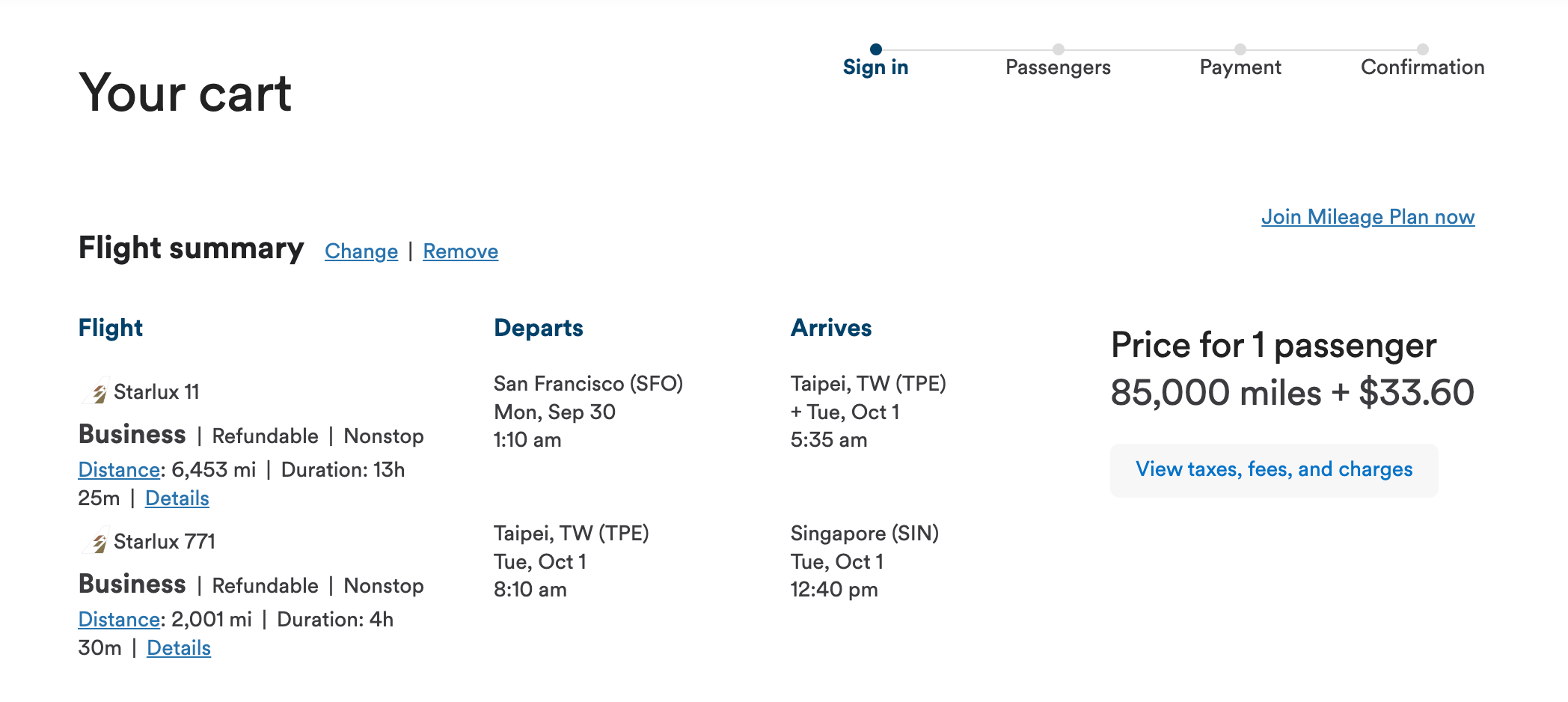
Under the new award chart, this flight would price out at the same 85,000 miles.
Cathay Pacific
Hong Kong-based Cathay Pacific has long been an incredible sweet spot with Alaska miles, with one-way award rates from the U.S. to Hong Kong International Airport (HKG) starting at 30,000 miles in economy, 50,000 miles in business class and 70,000 miles in first class. While availability in the carrier's premium cabins remains very scant, almost every Cathay gateway in the U.S. (aside from SFO) will see increased award rates under the new chart:
- Economy: 42,500 miles (up 41.67%)
- Business: 85,000 miles (up 70%)
- First: 130,000 miles (up 85.7%)
Related: Best Alaska Airlines Mileage Plan sweet spot redemptions
Other updates
Beyond the new 2024 award charts, Alaska is also teasing a number of additional updates to the Mileage Plan program:
- Increased partner award inventory : Alaska has long allowed you to use additional miles to book some partner award tickets (though these can be quite pricey ). The carrier has committed to opening up "increased award inventory on 10% of partner routes" to further expand this feature.
- New partner award sales : Starting in April 2024, Alaska will launch limited-time promotions and special pricing for specific routes, partners and/or destinations.
- Upcoming flexibility with partners : As of now, you can only combine Alaska-operated flights with partner-operated flights on one-way award tickets. However, the carrier is working on offering "mileage redemption when combining two partner airlines in a single itinerary on a one-way trip."
- No change to stopover policy : Alaska's award ticket stopover policy is one of the most generous out there, allowing you to add a stop of up to 14 days on one-way, international award tickets. This is not changing with the new award chart.
Our take on the Alaska changes
The new award chart is a mixed bag for Alaska travelers. Generally speaking, a distance-based award chart tends to benefit those who book shorter, nonstop itineraries — since adding a connecting flight increases the distance you fly and thus has the potential to push you into a higher pricing band. This logic appears to hold with Alaska's new award chart.
However, it's great to see unified pricing, and for those outside the U.S., it will be a nice enhancement to be able to book awards between two international destinations across all of Alaska's partners.
Of course, it's also worth noting that using "starting from" in a published award chart continues to add some notable uncertainty to booking award tickets with Alaska miles. While searching for award availability, we've seen fluctuating prices. After all, there's no guarantee that you'll be able to find an award ticket at that price on the date you want to travel.
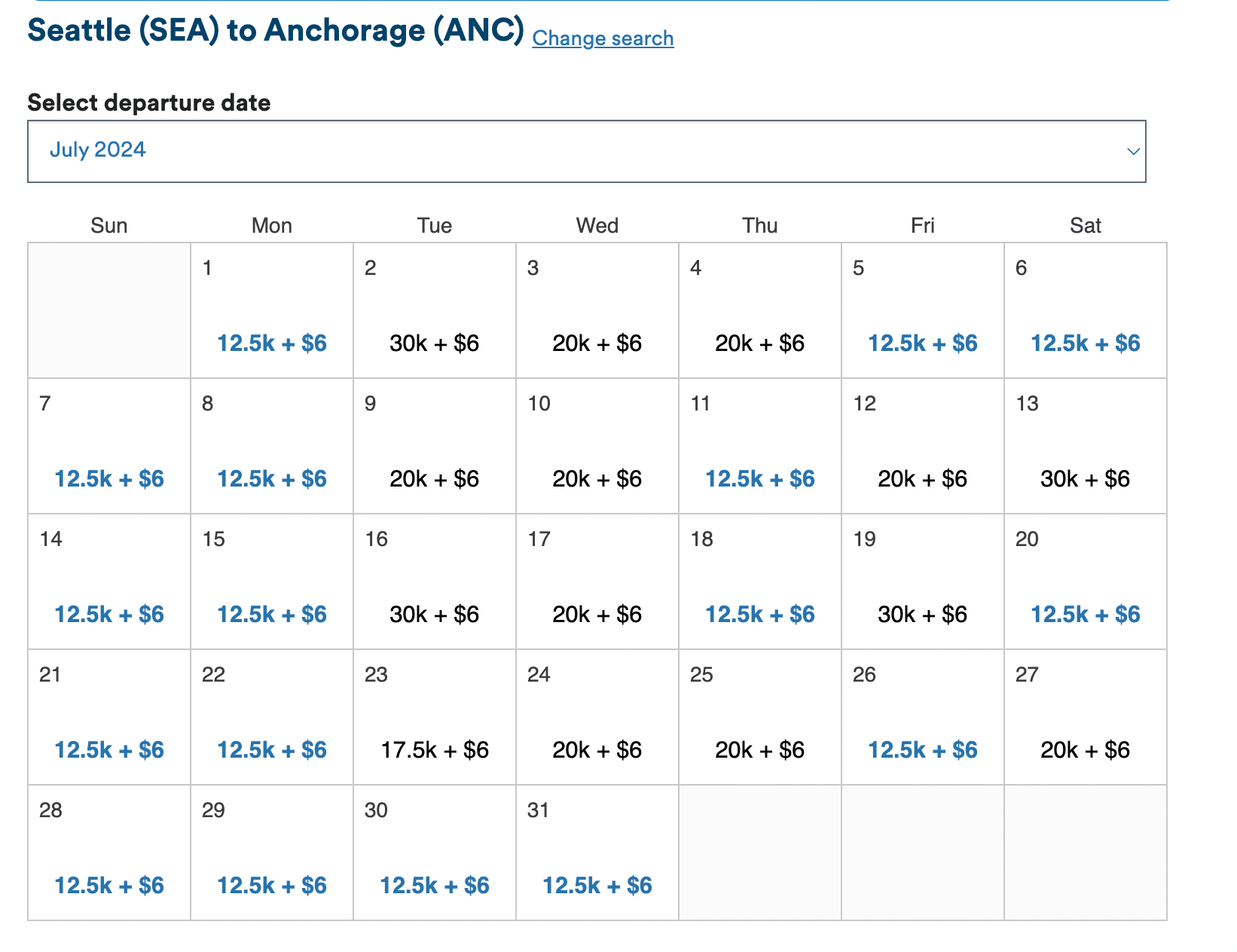
For example, checking Alaska's award calendar for flights from Seattle to Anchorage in July, there are one-way flights between 12,500 miles and 30,000 miles. Therefore, if you're flexible with your travel days, we recommend searching Alaska's award chart calendar, as you may find a cheaper redemption.
Bottom line
Alaska Airlines Mileage Plan overhauled its award chart, shifting to a distance-based model covering three regions: the Americas, Europe, the Middle East, Africa and Asia. This has led to some decreases in award prices, but some of the carrier's sweet spots will now require more miles.
However, this is not a fixed award chart and only shows introductory mileage rates. Therefore, we recommend checking Alaska's award chart calendar to find the cheapest redemption.


The Mystery Man on Alaska Airlines Planes: Who Is He?
H ave you ever noticed the friendly face on the tail of Alaska Airlines planes? It’s one of the most recognizable logos in the world, but the man behind the smile is a complete mystery!
Some people believe the face belongs to a real Alaska Native, maybe someone who once worked for the airline. Others think it’s a more general symbol of the people who live in Alaska.
The airline itself says the face isn’t based on any one person. They say it’s meant to represent the strength and history of Alaska’s Native people.
From Tiny Plane to Big Business: The Story of Alaska Airlines
Alaska Airlines wasn’t always the giant airline it is today. Believe it or not, it all started with one tiny plane and a dream! Back in 1932, a man named Linious McGee started McGee Airways with just one little plane that could only seat three people. It flew a route from Anchorage to Bristol Bay.
Things were tough during the Great Depression, but McGee Airways managed to hang on. In 1934, they merged with another small airline and became the biggest airline in all of Alaska! They even changed their name to Alaska Star Airlines in 1942.
A year later, they bought their first big plane, a fancy Lockheed Model 18 Lodestar. Finally, in 1944, they became the official Alaska Airlines we know today.
World War II made it hard to find pilots, but after the war, Alaska Airlines boomed. They bought a bunch of leftover military planes from the government and even became the first airline to fly a special kind of plane that could land on snow!
With their new fleet, Alaska Airlines did some amazing things. They even helped deliver supplies to Berlin during a big crisis.
From Tragedy to Transformation: The Story of the Alaska Airlines Logo
In 1971, Alaska Airlines suffered a terrible plane crash, the worst in US history at the time. This disaster, along with other challenges, put the airline in a tough spot financially.
To bounce back, Alaska Airlines decided on a big makeover in 1972. They got new leaders, new rules, and even some brand-new logos for their planes.
These new logos were all about Alaska’s history and the people who live there. There was a totem pole, a gold miner to remember the Gold Rush, and even some spires that looked like they came from Russia, which used to rule Alaska.
There was also a logo with a Native Alaskan wearing a parka. This one turned out to be the most popular, and people loved the friendly smile on his face. They called it the “Happy Face” logo.
The airline liked it so much they got rid of all the other logos and just kept this one. They even made the smile a little bigger in an update in 1987, and people loved it even more!
So, Who is the Mystery Man?
Believe it or not, even though everyone knows the logo, nobody knows for sure who the man on it is supposed to be! Some people have some funny guesses, like Abraham Lincoln or even a famous singer!
Others think it might be someone who used to work for the airline. There’s even a theory it’s based on a real guy named Chester Seveck, who used to greet people for Alaska Airlines tours.
The airline isn’t sure either, but most people agree that the logo represents the strong people who have lived in Alaska for a long time. The fact that nobody knows who the man is for sure just adds to the mystery and keeps the logo interesting!
- US Air Force Faces Challenges with E-7A Wedgetail Program
- Emergency Landing at Charlotte Airport: American Airlines Incident

- Boeing & Aerospace
Summer travel recovery restores Alaska Airlines’ stability, growth plans

Alaska Air Group posted record third-quarter revenue and strong financial results Thursday, stoked by high fares and full airplanes through the summer. After a nightmarish breakdown in its operations in the spring, the airline recovered in the quarter to lead the industry in on-time performance.
Despite recession fears and a large increase in labor costs from major contract deals with its pilots, Alaska Air CEO Ben Minicucci on Thursday proclaimed the airline was back on a growth trajectory.
From July through September, Alaska Airlines went a long way toward restoring its reputation for reliable service, which had been shredded in the spring when pilot and other staff shortages caused last-minute flight cancellations that ruined travel plans.
In response, Alaska cut its summer flying schedule, reducing capacity by about 7%. Even as other airlines continued to struggle with staff shortages, that pullback steadied Alaska’s operation.
“This summer we returned to delivering a reliable operation with a completion rate over 99% each month of the quarter,” Minicucci told analysts on an earnings call Thursday. That means less than 1% of flights were canceled.
Travel statistics on the U.S. Department of Transportation website show Alaska had the top on-time performance among all U.S. airlines in June and July. Aviation data company Cirium shows it ranking No. 2 in August behind Delta and No. 3 in September behind Delta and United.
Minicucci noted that Horizon Air, Alaska’s regional airline subsidiary, “also posted fantastic operating results with the No. 1 completion rate in the industry at 99.5%.”
“I want to thank all of our employees for a great summer and everything that they do,” Minicucci said.
Record revenue from high fares
Chief Financial Officer Shane Tackett said the company gave every employee 90,000 frequent-flyer miles “in recognition of all of their extraordinary work during the pandemic and our 90th anniversary as an airline.”
Tackett said with Alaska’s improved financial results, the company expects to pay out strong annual bonuses in January.
CEO Minicucci said 65 newly trained pilots are coming out of Alaska’s training school each month and the goal is to increase that to 100 per month.
He said the exceptionally large pay increases awarded last month to the entry-level pilots at Horizon Air “provides us a strong foundation for our efforts in attracting, retaining and building a robust pilot pipeline.”
The contract ratified this month with the Alaska Airlines mainline pilots adds further certainty to the pilot staffing.
“We are on track right now to deliver the pilots we need per month on both the regional and the mainline side,” Minicucci said.
With air travel demand high and fewer seats available, passengers were stuck with soaring ticket prices across the industry this summer and airlines raked in money as a result.
Alaska’s $2.8 billion in revenue for the quarter was the highest “ever recorded in our history,” Minicucci noted.
For the three months through September, Alaska posted a net profit of $40 million or 31 cents per share.
Adjusted to exclude one-time costs — including contract ratification bonuses after major labor deals with the pilots, as well as charges for retiring Airbus jets — the net profit was $325 million, or $2.53 per share, compared with an adjusted profit in the same quarter last year of $187 million or $1.47 per share.
However, the market reacted negatively to management’s outlook for the fourth quarter results. Alaska’s stock closed at $39.88, down $1.97 or 4.7% for the day.
American, Delta and United all reported record revenue and large profits in the third quarter. Each of those stocks also fell Thursday, but not as much as Alaska’s.
Wall Street analysts lowered their estimates for Alaska’s fourth-quarter results as management projected higher labor costs following the contract agreements with their pilots.
Most Read Business Stories
- REI reports another year of losses, pledges efficiency and new stores
- Russell Wilson’s $24.9 million Bellevue mansion has a potential buyer
- Seattle City Council rejects more density for affordable housing
- To fend off tourists, a town in Japan is building a big screen blocking the view of Mount Fuji VIEW
- Amazon reports $10.4 billion profit in first quarter of 2024
“Shares were down … on a 4Q outlook that falls short of consensus,” analyst Dan McKenzie of Seaport Global Securities told investors in a research note.
Staffing up
Tackett said one lesson management learned from the pandemic is that its staffing was too lean.
“Last year, we were trying to hire just in time to meet the new capacity, and then we’d get hit with a COVID wave and people would be sick and absent, and we could not operate,” he said. “Like others in the industry, we have totally done a 180 on that. We’re now carrying more people than we need.”
Carrying the additional staff cost an extra $15 million during the last quarter, Tackett said.
Meanwhile, Alaska Airlines is accelerating its effort to streamline its jet fleet and revert to being an all-Boeing carrier.
The airline is rapidly retiring its Airbus aircraft, replacing them with larger Boeing 737 MAXs. And regional airline subsidiary Horizon Air is replacing its Bombardier Q400 turboprops with Embraer E175 jets.
Alaska has 35 MAX jets today. By the end of next year, all the Airbus jets will be gone, and the airline expects to have 78 MAX jets, making up nearly one-third of its mainline fleet.
Between now and the end of the year, and into the first quarter of next year, Alaska will maintain its lower flying capacity as it retires the Airbus jets and retrains pilots to operate the MAX planes.
But the company expects to grow after that. The airline will be back to its 2019 size by the middle of next year, said Tackett, and will grow capacity beyond that, if demand holds.
CEO Minicucci said the “long-term plan is still to grow until 2025.”
Chief Commercial Officer Andrew Harrison told analysts that in the fourth quarter, even though Alaska will be flying 7% to 10% fewer seats than in 2019, it nevertheless expects revenue to increase by 12% to 15%, reflecting higher fares.
Beyond that time frame, Harrison predicted smooth operations, confident that the COVID-induced volatility and disruption of the first half of this year is firmly in the past.
“We’re going to set ourselves up next year to really operate this airline like a Swiss watch,” Harrison said.
The opinions expressed in reader comments are those of the author only and do not reflect the opinions of The Seattle Times.
FAA lifts ground stop of Alaska Airlines flights after system issues resolved
The Federal Aviation Administration lifted a ground stop that applied to all Alaska Airlines and subcarrier flights after about an hour Wednesday. The order was first instituted because of a software issue at the airline.
"This morning we experienced an issue while performing an upgrade to the system that calculates our weight and balance. Out of an abundance of caution, we requested a ground stop for all Alaska and Horizon flights, which was instituted at approximately 7:30 a.m. PT," Alaska said in a statement to USA TODAY. "The issue was mitigated and the ground stop for Alaska and Horizon flights expired at 8:30 a.m. PT. We have begun releasing flights. Residual delays are expected throughout the day. We apologize for the inconvenience and encourage guests to check the status of their flights on alaskaair.com or the Alaska App prior to heading to the airport."
The ground stop did not apply to Alaska flights operated by regional carrier SkyWest.
Although Alaska said it anticipates some delays throughout its system Wednesday as a result of the ground stop, as of 11:50 a.m. ET, the airline was not reporting any cancellations, according to FlightAware .
Zach Wichter is a travel reporter for USA TODAY based in New York. You can reach him at [email protected].

- Commercial Aircraft
- Vintage Aircraft
- Helicopters
- General Aviation
- Misc & Apparel
- Display Racks
- How It's Made
- Store Locator
- Affiliate Program
- PlaneTags Encyclopedia
Your Cart is Empty
- $0.00 Subtotal
Non-US Countries: Tariffs are not included and may vary depending on your country.
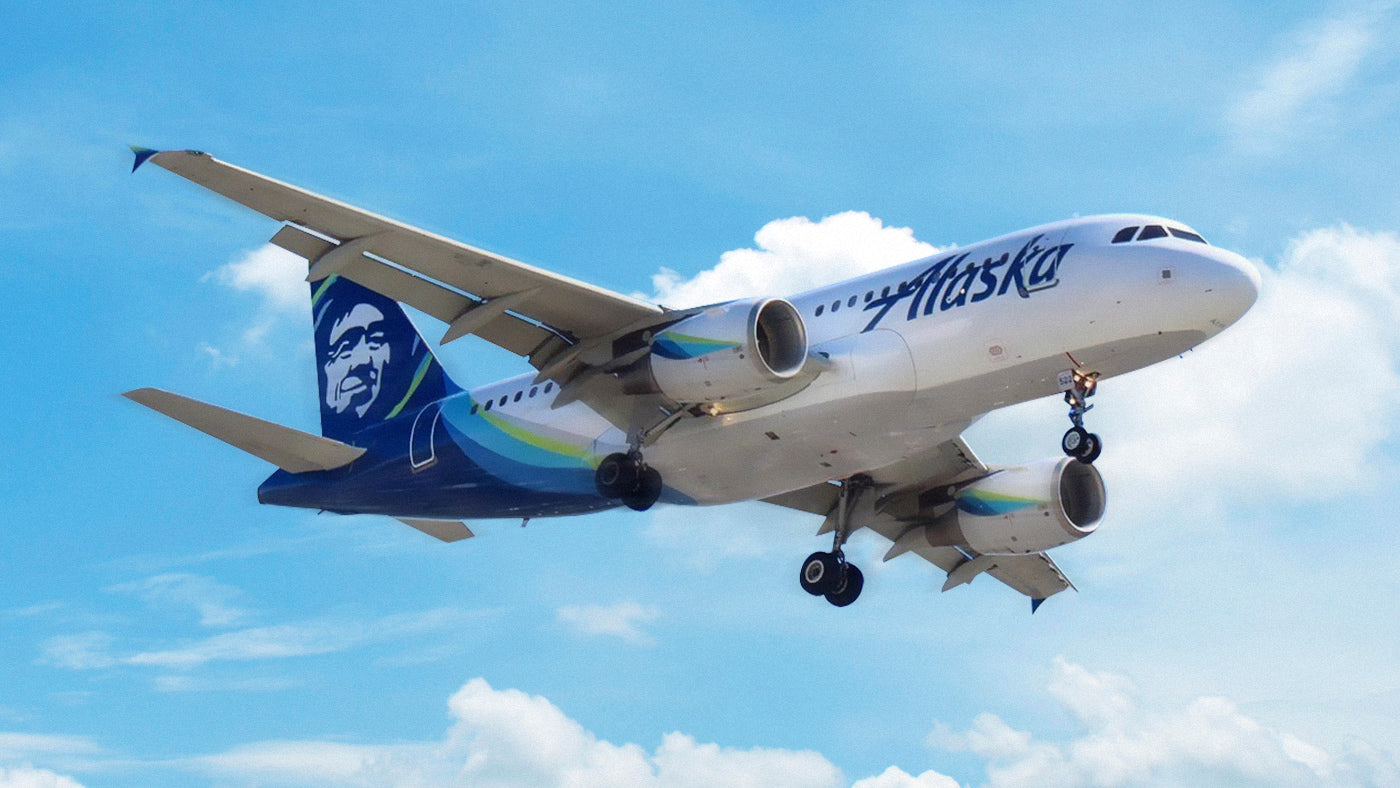
Alaska Airlines A319: Tracing the Path of Aviation History
October 26, 2023
In 2023, MotoArt and Alaska Airlines collaborated to create the first Alaska Airlines branded PlaneTags, made from N522VA, an Airbus A319. Read more about this plane’s history, then order your own Alaska Airlines A319 PlaneTags .
Alaska Airlines History
Alaska Airlines , one of the major airlines in the United States, boasts a rich history that dates back to the early 1930s. The carrier's origins can be traced back to 1932 when Linious "Mac" McGee established McGee Airways in Anchorage, Alaska. Operating at first with just a single three-seater Stinson aircraft, the company primarily focused on offering flights for passengers and cargo transportation throughout the Alaskan region, starting with unscheduled service between Anchorage and Bristol Bay.

Photo by Roy S Dickson, Sr
In 1934, McGee sold his airline to Star Air Service. In 1937, Star Air Service bought Alaska Interior Airlines, reincorporating the business as Star Air Lines. In 1941, the airline was purchased by Raymond Marshall, who then purchased three other Alaskan airlines. After changing the name to Alaska Star Airlines in 1942, it was finally and permanently changed to Alaska Airlines on May 2, 1944, reflecting the company's ambition to establish itself in the competitive aviation market and extend its reach beyond the Alaskan boundaries.
The post-World War II period witnessed a surge in the demand for air travel, prompting Alaska Airlines to expand its fleet and services, connecting various cities within the United States. By the 1960s, the airline had evolved into a significant player in the national aviation sector, facilitating smoother travel experiences for a growing number of passengers. Alaska Airlines continued to enhance its operations, introducing modern aircraft, refining its customer service, and expanding its route network. Over the decades, the airline has solidified its reputation for providing excellent service, ensuring passenger safety, and fostering strong community ties in the regions it serves.
Today, Alaska Airlines remains a prominent name in the aviation industry, known for its commitment to innovation, reliability, and customer satisfaction.
Alaska Airlines Fleet History

By SounderBruce - Own work , CC BY-SA 4.0 , Link
Alaska Airlines has a diverse and dynamic fleet history that has evolved in response to the changing demands of the aviation industry. In its early years, the airline operated small, single-engine aircraft, such as the three-seater Stinson Reliant, to serve the Alaskan region's remote and challenging terrain. As the airline expanded its operations and ventured into transcontinental flights, it incorporated larger propeller-driven planes like the Douglas DC-3, which played a crucial role in enhancing its capacity and reach across the United States.
In the 1960s and 1970s, Alaska Airlines embraced the era of jet travel, integrating modern and efficient jetliners into its fleet. The Boeing 727, known for its reliability and range, became a staple in the airline's fleet, enabling it to provide faster and more comfortable journeys for passengers traveling to various destinations. The Boeing 727's versatility and robust performance capabilities further facilitated Alaska Airlines' expansion into new markets, solidifying its position as a key player in the U.S. aviation landscape.
As air travel technology continued to advance, Alaska Airlines modernized its fleet with more fuel-efficient and environmentally friendly aircraft. The airline later incorporated the Boeing 737, a workhorse of the industry known for its reliability, cost-effectiveness, and passenger comfort. In its pursuit of operational excellence, Alaska Airlines also adopted the Airbus A320 family, including the A319 and A320, to cater to its growing domestic and international routes. The strategic incorporation of these modern and versatile aircraft has enabled Alaska Airlines to continue providing passengers with a seamless and enjoyable travel experience while also upholding its commitment to sustainability and environmental stewardship.
In September 2023, Alaska retired the last of its ten A321neo planes and reached an agreement to sell them to American Airlines. As of October 2023, Alaska Airlines has an all Boeing 737 fleet, with the following aircraft according to airfleets.net .
Where does Alaska Airlines fly?
As of 2023, Alaska Air Group serves more than 115 destinations with nearly 1,200 daily flights in the United States, Mexico, Canada and Costa Rica. This includes routes flown by Horizon Air and SkyWest, which provide feed traffic to Alaska Airlines under capacity purchase agreements.

On October 20, 2023, Alaska Airlines announced new seasonal non stop service added from Anchorage to New York City and San Diego . Beginning next June, daily flights to New York’s JFK airport will be the only nonstop service between JFK and Anchorage, offering the longest flight in the Alaska Air Group network. The 3,386 mile route will be served by the airline’s new 737-8 aircraft, which has the longest range of any of their current planes. These new routes will make 14 nonstop destinations to and from Anchorage in the summer to the lower 48 states and Hawaii.

Airbus A319
The Airbus A319, a member of the Airbus A320 family, is a narrow-body, twin-engine jetliner known for its versatility and efficiency. Designed for short to medium-haul flights, the A319 is often deployed on routes with high demand and moderate passenger traffic. Its compact size and excellent fuel economy make it an ideal choice for both regional and international operations, allowing airlines to efficiently serve destinations with varying demand levels.

Photo by cv880m , used with permission
The Airbus A319 features a sleek and aerodynamic design, characterized by its streamlined fuselage, swept wings, and modern, curved wingtips. Its spacious cabin is typically configured to accommodate anywhere from 124 to 156 passengers, depending on the airline's specific layout. The aircraft offers a comfortable travel experience, equipped with modern amenities and ergonomic seating arrangements to ensure passenger comfort during the flight.
The A319 is equipped with advanced avionics and navigation systems, contributing to its reputation for safety and reliability. Its efficient engines and aerodynamic design enable it to achieve impressive fuel efficiency, making it a popular choice for airlines aiming to reduce operating costs and environmental impact. Since its introduction in the mid-1990s, the A319 has garnered considerable popularity in the aviation industry, with hundreds of units manufactured to cater to the diverse needs of airlines worldwide. Its successful track record and widespread adoption have solidified its position as a key player in the market for narrow-body aircraft.
Airbus A319 At a Glance

A319 Specifications:
- Manufacturer: Airbus
- Type: A319-112
- Tail #: N522VA
- Crew: 5 (2 Pilots, 3 Flight Attendants)
- Passengers: 123 (12 First Class, 24 Premium Economy, 87 Economy)
- Wing Span: 111 Ft 10 In
- Length: 111 Ft 0 In
- Height: 38 Ft 7 In
A319 Performance:
- Range: 3,750 Nm
- Cruise Speed: 460 Kts
- Ceiling: 41,000 Ft
- Empty Weight: 87,930 Lb
- Max Takeoff Weight: 141,094 Lb
- Rate Of Climb: 2,500 Ft/Min
- Engine: 2x Cfmi Cfm56-5b6 Turbofans

Photo by Chris Jacobs , used with permission
N522VA, an Airbus A319-112, took its first flight June 16, 2006. Shortly after, on June 29, 2006, it was delivered to Virgin America. It was leased to Skybus Airlines in February 2007. Skybus operated from May 2007 to April 2008, with a fleet of thirteen Airbus A319 aircraft, including N522VA.

Virgin America Airbus A319-112 N522VA (cn 2811) "the 1-year-old virgin" flickr photo by TDelCoro shared under a Creative Commons (BY-SA) license
After Skybus ceased operations, N522VA was returned to Virgin America in July 2008 and nicknamed “the 1-year-old virgin”. Virgin America was a low-cost but high service quality airline that operated between 2007 and 2018, primarily operating from its hubs at SFO and LAX and offering flights to major metropolitan areas on the east coast. Virgin America’s all Airbus fleet included, at its peak, ten A319, 53 A320, and four A321s.

Alaska Airlines and Virgin America merged operations in 2018, bringing N522VA back into the Alaska fleet until its eventual retirement in March 2020. It landed at Marana Pinal Airpark in October 2021.
MotoArt Gets an Alaska Airlines A319

MotoArt owner Dave Hall discussed how the team ended up with N522VA, their first A319 PlaneTags. “Alaska Airlines first approached us earlier this year about doing a collaboration together on PlaneTags,” said Hall. “Even though Alaska has turned into an all Boeing fleet, the easiest accessible retired aircraft was the A319, which were originally Virgin Atlantic aircraft that they acquired in the merger.”

How were the Alaska Airlines A319 PlaneTags made?

The process for manufacturing the Alaska Airlines A319 PlaneTags was a long and difficult one, according to Dave Hall. "These photos are important because the colors were not available to us initially," says Hall. " The MotoArt crew spent weeks uncovering the original livery that had been hidden under the cover-up paint. None of these vibrant colors would have been possible without the team working hard to find it without screwing up the original paint."

Alaska Airlines A319 PlaneTags

Our Alaska Airlines A319 PlaneTags will be released on Thursday, October 26th at 12pm PDT. They are numbered in a series of 3000 and will be available in the following colors:

Airline Branded PlaneTags
What branded airline planetags has motoart made.
In addition to Alaska Airlines, MotoArt has created branded commercial PlaneTags from many iconic airlines, which include:
- Air Canada Airbus A320
- WestJet 737
- Northwest DC-9
- US Airways 757
- Aloha Airlines 737
- Delta CRJ 200ER
- Delta L-1011
- Air Transat A310
- Atlas Air 747
- Delta MD-90
- Delta MD-88
- Eastern DC-8
- Eva Air 747
- Aero California DC-9
- British Airways 767
- Aeroflot MD-11F
- All Nippon Airways 777
- Thai Airways 747
- All Nippon Airways 767
- Korean Air 747
- China Airlines A340
- Eastern Airlines DC-9
- Japan Airlines 777
- Virgin Atlantic A340 Queen of the Skies
- Virgin Atlantic A340 Varga Girl
- Allegiant MD-80
Sign up to get the latest on sales, new releases and more …
Simple Flying
Alaska airlines marks 22 years of service at denver international airport.
The airline began serving the airport in 2002.
- Alaska Airlines is celebrating more than two decades of operations at Denver International Airport.
- The carrier has served over 8.5 million passengers through Denver all these years.
- Despite some of the challenges this year, Alaska Airlines continues to expand its flight network and maintain high customer satisfaction ratings.
Airlines and airports have a strategic relationship, benefitting from each other’s services and, in many cases, lasting for years and decades. And Alaska Airlines and Denver International Airport recently celebrated one such milestone, with Alaska marking 22 years of service in Denver.
Two decades of service
Alaska Airlines has been flying to Denver International Airport (DEN) for more than two decades. The carrier’s inaugural service to DEN was on April 28, 2002, with three daily departures to Seattle-Tacoma International Airport (SEA). Today that has increased to several more flights across multiple destinations. DEN CEO, Phil Washington, commented,
“We are extremely appreciative of Alaska Airlines’ commitment to DEN and our community over the last 20 years. Not only do they help connect our community to the world, but they share similar values as DEN through their commitment to diversity and equity in education. We look forward to many more years of partnership that will continue to positively impact our community.”
Over 8.5 million passengers served
While multiple airlines connect passengers from Denver to Seattle, Alaska Airlines takes the crown of being the top carrier, capturing passenger demand between the two destinations. Since 2002, it has transported more than four million passengers between Denver and Seattle and more than 8.5 million passengers on its flights through DEN.
What started as a service between Denver and Seattle has now extended to two other destinations: Portland and Anchorage. In 2002, Alaska had three daily departures to Seattle-Tacoma International Airport. Today, it has an average of seven flights daily to three destinations and, according to Cirium Aviation Analytics , over 370 return flights to and from Denver in May. Brett Catlin, vice president of network and alliances at Alaska Airlines, commented,
“We continue to grow in Denver, including with new flights to Anchorage and Portland over the past two years. As new infrastructure at the airport comes online, we look forward to potential opportunities in the years ahead.”
Home Of The Pancake Machine: A Brief Guide To Alaska Airlines' Lounges
Other alaska airlines news.
The airline has had a mixed year so far. In January, Alaska was in the news for the midair blowout incident of one of its Boeing 737 MAX 9 aircraft, which started another series of inspections for Boeing and temporarily grounded all of Alaska’s MAX 9 planes. The carrier was recently also compensated by Boeing for the losses incurred from operational disruptions following the incident.
Still, it managed to rank as the top American airline for the second year in a row , according to the ACSI Travel Study, with a score of 82. The study was based on interviews with 16,352 customers randomly chosen and contacted via email between April 2023 and March 2024.
Alaska has also been expanding its flight network in California , offering more flights and expanding services from LAX and San Diego. It recently announced that it will launch new routes from San Diego to Harry Reid International Airport in Las Vegas from October 1 and will fly nonstop from LAX to Pasco/Kennewick (Tri-Cities).
In October, Alaska will also start connecting Santa Rosa to Vegas, operating the service year-round on the E175. This will be its seventh destination from the Northern California airport.
What are your views on this report? Please leave a comment below.
Alaska Airlines
Denver international airport.
Alaska Airlines was named America's favorite airline for the 2nd year in a row — months after a hole blew in the side of one of its planes
- A major consumer survey found that Alaska Airlines is the most popular airline in the US for the second year running.
- The airline topped the American Customer Satisfaction Index, despite its infamous panel blowout in January.
- Overall, US air travel customers were happier than last year with their experiences.

Alaska Airlines is the most popular airline in the US for the second year running, according to a major consumer survey.
The airline comfortably topped the annual American Customer Satisfaction Index with a score of 82, a one-point improvement compared to 2023.
American Airlines was second with 79 points, while low-cost carrier Allegiant Air beat better-known legacy names like United and Delta to take third place. Allegiant registered a four-point rise in overall customer satisfaction, making it one of the fastest climbers this year.
United Airlines was the only carrier to lose ground, sliding three points to a score of 75.
The index, which has been running since 1994, tracks customer satisfaction across five travel industries — airlines, car rentals, lodging, online travel agencies, and ridesharing platforms.
Related stories
To determine the rankings, 16,352 customers were asked to rate their experiences with companies based on nineteen different factors, such as ease of making a reservation, check-in process, cleanliness of cabin and lavatory, courtesy and helpfulness of flight crew, and timeliness of arrival. By collating this information, the American Customer Satisfaction Index says it provides a "definitive measure of passenger satisfaction."
Alaska Airline's top ranking comes despite the airline's nightmare safety incident in January 2024, during which a decommissioned door plug flew off during one of its flights at an altitude of 16,000 feet.
The plane, a Boeing 737 Max 9 made a safe landing back at Portland International Airport 35 minutes after takeoff, with all 177 people on board surviving.
14 passengers on the flight have since filed a class-action lawsuit against Boeing and Alaska Airlines, asking for monetary damages to cover injuries sustained during the incident and claims that some oxygen masks malfunctioned.
US airlines are getting better
Overall, the data found that customers were increasingly happy with airline travel, with ratings for all nineteen areas of customer satisfaction across airlines either improving or staying level with responses from 2023.
The polled customers were particularly happy with app services, the ease of making reservations, and airlines' websites, pointing to the importance of developing customer-friendly technology offerings.
As they become happier with travel experiences, customers are also travelling more. This February, the International Air Transport Association (IATA) reported a 21.5% rise in global air passengers compared to the previous year.
Watch: Why Hooters Air, Pan Am, and the Concorde all disappeared from the skies
- Main content
We use cookies to improve your experience on our site. To find out more, read our privacy policy .
Jobs at Alaska Airlines & Horizon Air
Thank you for your interest in our airlines! Current career opportunities are extremely limited due to the COVID-19 outbreak. But if you’re interested in a future role, please join our Talent Community or follow us on social media. We look forward to connecting with you soon. Until then, be safe and well.
Job Information
Horizon air ground service agent in portland , oregon.
Company Horizon Air
Our airport teams work together to move guests and their belongings from curb to cabin, creating remarkable experiences along the way. Whether customer-facing or behind the scenes, we want to hear from you if you can be welcoming to people from all walks of life, think on your feet, and manage a flexible schedule. In return, you’ll receive a competitive total rewards package, professional development opportunities, and other benefits that are all designed to take you places.
Role Summary
The Ground Service Agent works in a fast-paced environment performing activities related to working on the airport ramp and keeping flights running smoothly and safely.
Load and offload luggage and cargo, transporting to various airport locations.
Distribute all paperwork to flight crews including fuel slips, load plans, cargo manifests and flight releases.
Marshals and pushes back aircraft.
Prepares weight and balance forms and ensures load integrity by inputting accurate commodity codes and weights into a data entry system.
Service aircraft as necessary to include lavatory, potable water, aircraft grooming, deicing and security searches.
Operates and/or drives multiple types of equipment, such as belt-loaders, tugs, air-start units, bag carts, lavatory carts and deice trucks.
Execute aircraft tow operations if required.
Performs other duties as assigned.
Day in the Life
For a preview of a day in the life of a Horizon Ground Service Agent, view the video below.
If you are unable to view the video, click this link: https://alaskahorizoncareers.com/qxgsa
Job-Specific Experience, Education & Skills
Strong written and verbal communication skills.
Ability to juggle multiple tasks in a fast-paced environment.
Valid driver's license.
Ability to consistently lift 50 pounds.
Must be able to stand for long periods of time.
Must be able to bend, stoop, squat, reach and grasp.
Ability to perform basic mathematics.
Ability to work a flexible schedule including nights, weekends and holidays.
Ability to participate in paid training that may require overnight travel.
Ability to obtain USPS Mail Handling Certification.
Ability to obtain airport security clearance.
Ability to communicate in English, high school diploma or equivalent, minimum age of 18, and authorization to work in the U.S.
Airport SIDA Badge Requirements
Important update for non-crew employees working at an airport or maintenance hangar: Employees will be required to obtain a SIDA badge provided by the airport authority and maintain good standing in order to keep their SIDA badge. Review theSIDA Badge Requirementsdocument for a comprehensive overview.
Job-Specific Leadership Expectations
Embody our values to own safety, do the right thing, be kind-hearted, deliver performance, and be remarkable.
Starting Rate
USD $18.00/Hr.
Total Rewards
Alaska Airlines and Horizon Air pay and benefits can vary by company, location, number of regularly scheduled hours worked, length of employment, and employment status.
Free stand-by travel privileges on Alaska Airlines & Horizon Air
Comprehensive well-being programs including medical, dental and vision benefits
Generous 401k match program
Quarterly and annual bonus plans
Generous holiday and paid time off
For more information about Alaska/Horizon Total Rewards please visit our career site and view benefits.
FLSA Status Non-Exempt Employment Type Full-Time Regular/Temporary Regular Requisition Type Frontline Apply by 7:00 PM Pacific Time on 5/2/2024 Location Portland, OR - Airport Equal Employment Opportunity We are proud to be an Equal Employment Opportunity (EEO) and Affirmative Action (AA) employer that is committed to diversity, equity, and inclusion. We take affirmative action to ensure equal opportunity for all qualified applicants and employees and do not discriminate based upon race, color, religion, sex (including pregnancy, childbirth, reproductive health decisions, or related medical conditions), sexual orientation, gender identity, gender expression, national origin, age, protected veteran or disability status, genetic information (including family medical history), political views or activity, or other legally protected characteristics. We also consider qualified applicants with criminal histories, consistent with applicable federal, state, and local law. We may use your information to maintain the safety and security of Alaska Airlines and Horizon Air, its employees, and others as required or permitted by law. People of color, women, LGBTQIA+, immigrants, veterans, and persons with disabilities are encouraged to apply. Featured Job Yes I: Y - GSA Z: Y - FL Need help finding the right job? We can recommend jobs specifically for you! Job Locations USA-OR-Portland Requisition ID 2024-12221 Category Airports & Warehouse Workplace Type Onsite
Current Search Criteria
- Horizon Air
- Ground Service Agent
We are experiencing issues with the EasyBiz travel portal. We apologize for the inconvenience and are working to resolve the issue. Please try again later.
- Help center
- Sign up Sign up
- Overview and elite status
- Discount and companion fare codes
- Mileage activity
Reservations
- Group travel
- Flight Pass Notice indicator that this external link may not follow the same accessibility or privacy policies as Alaska Airlines.
Trip planner
- Travel insurance
- Hotels Notice indicator that this external link may not follow the same accessibility or privacy policies as Alaska Airlines.
- Cars Notice indicator that this external link may not follow the same accessibility or privacy policies as Alaska Airlines.
- Vacations Notice indicator that this external link may not follow the same accessibility or privacy policies as Alaska Airlines.
Travel credits
- Credit certificates
- Gift certificates
- Wallet funds
- Check certificate balance
To view trip details, change seats, change dates or times for select reservation types , or cancel a current reservation, use your confirmation code. To apply the value of an unused ticket towards a new reservation, use your e-ticket number.
View hotel, car, and vacation reservations
- Hotels reservation Notice indicator that this external link may not follow the same accessibility or privacy policies as Alaska Airlines.
- Cars reservation Notice indicator that this external link may not follow the same accessibility or privacy policies as Alaska Airlines.
- Vacations reservation Notice indicator that this external link may not follow the same accessibility or privacy policies as Alaska Airlines.
Check in anytime between 1 and 24 hours before your scheduled departure.
NAME Complete check-in for your trip. Confirmation code: CONFCD
Where we fly
- Destinations
- Global travel
- Flight schedules
Things to do
- Fly Alaska Ski Free
- Relax on a beach
- Wine Flies Free™
- Fly to Disneyland ® Resort
- Travel experiences
- First Class
- Premium Class
- Food and beverage
- Alaska Lounge
Policies and services
- Infants and children
- Accessible services
- Sustainability
- Our aircraft
- All policies
Upcoming travel
- Check-in options
- Travel tips
- Travel documents
- Flight status
- Flight notifications
- Airport Guides
- Member benefits
- Elite status
- Alaska Access
- Airline partners
- one world ® Alliance
Earn and use miles
- Award charts
- Mileage Plan™ Shopping Notice indicator that this external link may not follow the same accessibility or privacy policies as Alaska Airlines.
Alaska Credit Cards
- US Visa Signature ® Apply for an Alaska Airlines US Visa Signature credit card
- US Business Visa ® Apply for an Alaska Airlines US Business credit card Notice indicator that this external link may not follow the same accessibility or privacy policies as Alaska Airlines.
- Companion fare Q&A Learn more about Companion fare Q&A
- Check activity
- Book award travel
- Buy and share miles
- Missing credit
- Find my Mileage Plan™ number
- shopping cart
Sign in/Sign up
Traveling with us
Mileage plan.
- Profile and settings
- Alaska Airlines/EasyBiz
- Rides Notice indicator that this external link may not follow the same accessibility or privacy policies as Alaska Airlines.
- Trip protection
- Helpful links
Day of travel
Manage reservations.
- View/change flights
- Cancel/refund flights
- Price guarantee
Manage account
- Customize features
- Company information
- Traveler profiles
- Ticket reports
Manage users
- Invite users
- Invite alternate
- Delete users
Credit cards
- View credit cards
- Add a credit card
EasyBiz Wallet
- Transactions
- Expiration dates
EasyBiz Mileage
- Earn/use miles
- Purchase gift certificates
EasyBiz discount and companion fare codes
- My site contact
- My account help
- EasyBiz user guide
EasyBiz FAQ
- Administrative
Terms and conditions
- Membership responsibilities
- Employee participation
- EasyBiz Administrator
- search Search
- shopping cart Cart
EasyBiz account
- Alaska for Travel Agents
- Name correction/transfer
- Void exchange
- Schedule change
- All ticketing
Agent policies
- Commissions
- Irregular operations policy
- Saver fare reference guide
- Reduced rate travel
- Travel agent newsletter
- All resources
- Elite levels
- Children traveling alone
- First Class upgrades
- Airport guides
Traveler info

These Are The Best Airlines To Fly This Year
WalletHub's report on the best airlines in 2024 makes it easier to choose which airlines to fly with on that next vacation!
- SkyWest Airlines ranks second overall in the US among the best airlines, known for exceptional service, reliability, and an extensive route network for major carriers.
- Spirit Airlines is recognized as one of the safest low-cost airlines, making advancements in safety while still offering reasonable prices.
- Alaska Airlines has reclaimed the top spot as the best airline in the US, excelling in affordability, in-flight comfort, safety, and overall performance metrics.
Getting ready for that next trip but indecisive about which airline to take? No worries! A report by WalletHub is ready to help. It evaluated major US airlines based on 13 criteria divided into three major categories: in-flight comfort and cost, baggage and departures, and safety. As for the metrics, they include cancelation rates, delays, mishandled baggage, denied boarding, in-flight amenities, price, and safety records.
Airlines were scored based on specific criteria for each metric. The detailed scoring framework is provided, emphasizing factors like flight cancelations, legroom, entertainment options, Wi-Fi availability, complimentary refreshments, price competitiveness, and others.
In a time when airlines will now owe money to passengers for mistakes , such as cancelations, delays, and lost baggage, among others, there's never been a better time for them to improve their services and impress. According to WalletHub's findings, these are the best airlines to fly this year that have done precisely that and more, having flown above and beyond.
These Are The Airlines With The Happiest Pilots
7 hawaiian airlines, score: 48.30.
Hawaiian Airlines has won several awards throughout the years, including being recognized by the US Department of Transportation as the airline with the best punctuality every year since 2004 .
This airline is well-known in Hawaii for having a significant impact on the development and current history of the state. It is the biggest and most established airline in the state , and in 2029 it will celebrate its centenary.
Hawaiian Airlines provides nonstop service to ten overseas locations in Asia and the South Pacific, in addition to several cities in North America and all the major Hawaiian Islands. Island-hopping travelers will board a Boeing 717, which is intended for short-haul travel.
6 JetBlue Airways
Score: 51.60.
JetBlue Airlines, one of the best airlines in the US, offers three classes of service: economy, Even More Space, and Mint, each with various amenities. Boarding occurs in 10 groups, prioritizing disabilities and loyalty status. Its loyalty program, TrueBlue, offers multiple tiers for frequent flyers. JetBlue primarily serves the U.S., Caribbean, and Latin America, with some transatlantic routes.
While it's not part of a major alliance, it partners with several airlines. Pricing is competitive, and points can be earned through flights and partners. Safety ratings are high, but operational reliability varies. Travelers are recommended to consider JetBlue if they prioritize affordability, comfort, and connectivity, but they should note its route limitations and operational performance.
According To Flight Attendants: These Are The Strictest Airlines To Work For
5 united airlines, score: 51.96.
Offering an extensive and constantly expanding network of worldwide destinations, the Chicago-based carrier, United Airlines, has eight hubs around the United States and connects travelers to hundreds of international destinations.
In fact, three island locations that have historically proven difficult to reach from the United States are among the recent additions to its destination roster. These are the Azores, Mallorca, and the Canary Islands.
In recent years, the airline has added 270 more Boeing and Airbus aircraft to its fleet. In addition to being more luxurious and technologically advanced, the new aircraft is anticipated to save carbon emissions by 17 to 20 percent per seat when compared to earlier models, making it more appealing and one of the best airlines to fly with this year.
Environmentally focused travelers may be interested in knowing more about going green when traveling .
The Best Low-Cost Airline In Europe For 2024
4 delta air lines, score: 61.56.
High honors are still given to Delta for the caliber of its in-flight services and its on-ground amenities, which include luxurious Sky Clubs at major American airports. An example of this can be found at the airline's magnificent new $4 billion terminal at the renovated LaGuardia Airport in New York , which features high ceilings, wood and marble accents, and eye-catching works by regional artists.
Additionally, Delta is attempting to make flying as easy as possible with its high-tech advances during boarding and check-in. Additionally, free text messaging and comfortable Delta One business class suites on its new Airbus A350 jetliners and other wide-body aircraft are appreciated by passengers as in-flight amenities.
Travelers will be able to take advantage of these benefits on travels to even farther-flung locations, such as Tahiti and Cape Town, because of an increasing route map.
3 Spirit Airlines
Score: 65.69.
Spirit Airlines has the third position among the top-rated airlines in the US to fly this year in WalletHub's report. Spirit Airlines is typically seen as low-cost travel and might not always be seen as a competitor when it comes to overall service quality. However, it appears that Spirit has advanced significantly in areas like safety that go beyond price.
Travelers are beginning to value the airline more and more, as seen by its ranking as one of the safest low-cost airlines in 2024 . Spirit Airlines' exceptional record in several safety criteria, such as incident and accident rates, has earned it the title of the safest airline . Additionally, Spirit Airlines is said to be the least expensive airline in 2024 , providing flights at reasonable prices.
These 10 Airlines Are Putting Sustainability At The Forefront (& Why It Matters)
2 skywest airlines, score: 65.96.
SkyWest Airlines is the second-best airline in the United States according to WalletHub , renowned for its exceptional service and reliability. Operating as a regional airline for major carriers like Delta, United, American, and Alaska Airlines, SkyWest maintains an impressive fleet and an extensive route network across North America. It is known for its safety record and consistently earns high marks for on-time performance and customer satisfaction.
SkyWest's commitment to quality extends to its fleet, featuring modern aircraft equipped with the latest amenities and technology. Moreover, its professional and courteous staff ensures passengers receive top-notch service throughout their journey. With a focus on safety, reliability, and customer service, SkyWest Airlines continues to excel as one of the best airlines in the US, earning the trust and loyalty of travelers nationwide.
1 Alaska Airlines
Score: 68.07.
Alaska Airlines knocked over Delta Air Lines, which was placed first as the best airline in 2023 and 2022 , to be named the top airline in the United States according to this year's study, which had the highest WalletHub score. Alaska Airlines has been named #1 in several previous WalletHub rankings, including those from 2021, 2019, 2018, and 2017 .
Relentless performance and a dedication to customer satisfaction vaulted Alaska Airlines back to the top of the rankings. The best airline has reclaimed the number one spot because of its outstanding and steady performance on several different criteria. The airline has surpassed expectations in terms of affordability and comfort for in-flight entertainment, offering free beverages, lots of legroom, and a variety of entertainment selections.
It has also shown to have strong safety protocols, as seen by its top position in safety-related metrics, including the number of injuries sustained in aviation mishaps and incidents.
The airline's return to the top spot has been facilitated by its balanced performance across many aviation-related metrics. Furthermore, it is not unexpected that its route map, which stretches from Hawaii to New York and from the Pacific Northwest to Mexico and Latin America, has surpassed the geographical boundaries of its name.

IMAGES
COMMENTS
If you completed your trip: Less than 48 hours ago: Sign into your My account profile in "My trips" section for an online receipt. In the last 12 months or less: Call customer care at 1-800-654-5669. In the last 12-18 months: Fill out a ticket copy request form and pay a research fee.
Alaska Airlines. From two competing charter services formed in Anchorage, Alaska, in 1932, Alaska Airlines has grown into the fifth-largest airline in the United States. It began operating under the name Alaska Airlines in 1944 and was first known as a cargo carrier. Passenger traffic increased in the 1960s and 1970s, but the airline remained a ...
A troubling start to the 1970s. In 1971, the airline faced a significant setback when Flight 1866 from Anchorage to Seattle via Cordova, Yakutat, Juneau, and Sitka ( a kind of milk run ), crashed in Juneau. According to the Juneau Empire, it was the worst air disaster in Alaska history- even to this day.
Alaska Airlines is a major airline in the United States headquartered in SeaTac, Washington, within the Seattle metropolitan area.It is the fifth-largest airline in North America when measured by scheduled passengers carried. Alaska, together with its regional partners Horizon Air and SkyWest Airlines operates a route network primarily focused on connecting cities along the West Coast of the ...
Alaska Airlines, with the IATA code AS, has a rich history that dates back to 1932. It is currently the fifth-largest airline in the United States and operates a vast network of domestic and international flights. The airline was originally founded as McGee Airways in 1932 by Linious "Mac" McGee. It started with a single three-passenger Stinson ...
30 daily flights from 10 West Coast cities. In the past 10 years, Alaska has grown to as many as 26 daily flights to Hawaii - 30 including Virgin America. Hawaii now accounts for about 15 percent of our route network. "Hawaii flying has meant quite a lot overall to both the company and its passengers," said Captain Kevin Earp, who flew ...
Much of Alaska Airlines' history parallels the growth of its namesake state. Born during the Great Depression, the company evolved from a bush carrier to a major airline. It began as a gnat-sized ...
Receipts for past reservations or service fees. The process for getting a copy of your receipt for past reservations or service fees paid depends on when your travel took place.If you completed your trip: Less than 48 hours ago: Sign into your My account profile in "My trips" section for an online receipt.
Based on interviews, newspaper accounts, books, and supporting documents, this history of Alaska Airlines tells of the company's triumphs and tragedies during the pioneer era of aviation in the land known for cold and gold. This book was written as an alternative history to that which is portrayed in the book The Alaska Airlines story by Archie Satterfield and in the May 2017 issue of Alaska ...
Together with its partners, Horizon Air and SkyWest Airlines, Alaska Airlines runs a vast domestic network flying to over 115 destinations in the U.S, Canada, Costa Rica, and Mexico. Here are a few stats that showcase Alaska Airlines' growing stature as a major U.S airline: Total sales revenue of $3.57 billion in 2020.
Whether consolidating your business travel expenses, checking travel dates when submitting an airline compensation claim, or simply trying to recount a memorable trip, there can be many instances in which accessing past flight information becomes essential. Thankfully, modern-day tools have made this more convenient than ever.
Search for a reservation. Last name. Confirmation code or e-ticket #. View or change your reservation from your mobile device.
Alaska Airlines Mileage Plan 2024 award chart redemption changes. Beginning on March 11, Alaska Airlines started rolling out its new award chart pricing changes. The Mileage Plan award chart now has a new distance-based structure and is divided into three region-based charts: the Americas; Europe, Middle East and Africa; and Asia-Pacific.
As you can see by Alaska Airlines' 2016 montage of past and now present liveries, Alaska Airlines' look has changed and grown with the airline. From the days of bare metal and minimal paint to today's multi-color flying art - Alaska Airlines' livery has reflected a growing airline and differing personalities along the way.
In 1971, Alaska Airlines suffered a terrible plane crash, the worst in US history at the time. This disaster, along with other challenges, put the airline in a tough spot financially.
Alaska's $2.8 billion in revenue for the quarter was the highest "ever recorded in our history," Minicucci noted. For the three months through September, Alaska posted a net profit of $40 ...
Out of an abundance of caution, we requested a ground stop for all Alaska and Horizon flights, which was instituted at approximately 7:30 a.m. PT," Alaska said in a statement to USA TODAY.
Read more about this plane's history, then order your own Alaska Airlines A319 PlaneTags. Alaska Airlines History Alaska Airlines, one of the major airlines in the United States, bo ... In the 1960s and 1970s, Alaska Airlines embraced the era of jet travel, integrating modern and efficient jetliners into its fleet. The Boeing 727, known for ...
Alaska Airlines is celebrating more than two decades of operations at Denver International Airport. The carrier has served over 8.5 million passengers through Denver all these years. Despite some of the challenges this year, Alaska Airlines continues to expand its flight network and maintain high customer satisfaction ratings.
Alaska Airlines is the most popular airline in the US for the second year running, according to a major consumer survey. The airline comfortably topped the annual American Customer Satisfaction ...
Alaska Airlines and Horizon Air pay and benefits can vary by company, location, number of regularly scheduled hours worked, length of employment, and employment status. Free stand-by travel privileges on Alaska Airlines & Horizon Air. Comprehensive well-being programs including medical, dental and vision benefits. Generous 401k match program
Want to know about the history of Alaska Airlines? Start here to find out about our roots. Special travel instructions are in effect for multiple regions. Baggage fee updates for domestic and international travel. We are experiencing issues with the EasyBiz travel portal. We apologize for the inconvenience and are working to resolve the issue.
Alaska Airlines has reclaimed the top spot as the best airline in the US, excelling in affordability, in-flight comfort, safety, and overall performance metrics. ... This airline is well-known in Hawaii for having a significant impact on the development and current history of the state. ... Spirit Airlines is typically seen as low-cost travel ...
To view your trip details, change seats, change dates or times for select reservation types, or cancel a current reservation, use your confirmation code. To apply the value of an unused ticket towards a new reservation, use your e-ticket number. Passenger's last name. Confirmation code or e-ticket #. 3,000 miles off. Save on award redemption ...
Southwest Airlines announced Thursday it will stop serving four airports after reporting increased losses in the first quarter and more delays in the delivery of promised jets from Boeing.
CNBC
User ID. Name. Preferred cities. (if stored in your account) No. If you are using a public computer, or do not want alaskaair.com to remember your user ID and other preferred fields, do not select 'Remember me.'. 3,000 miles off. Save on award redemption stays with Alaska Hotels until April 29, 2024. Online-only offer.
New members, join now and save $25* on your next flight. You don't need to be a frequent flyer to fly like one. Save on award redemption stays with Alaska Hotels until April 29, 2024. Online-only offer. Offers vary elsewhere. When you fly Alaska Airlines, find flights to 1,000+ destinations worldwide with oneworld® Alliance member airlines and ...